Learn Computer Science
Explore the World Of Computer Science
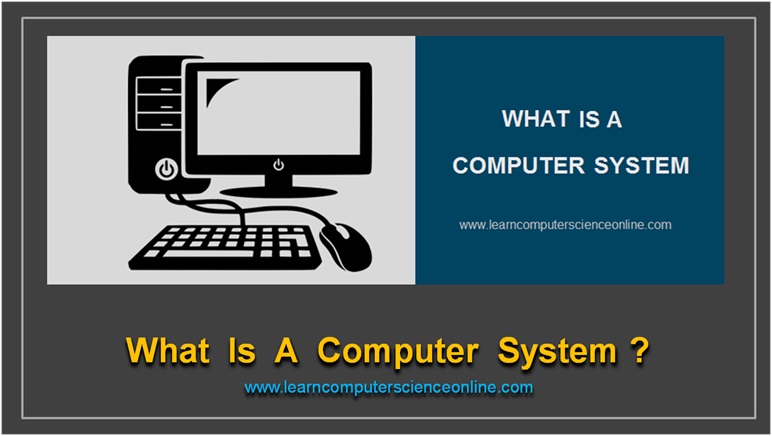

Introduction To Computer System
What is computer system .
In this introduction to computer system , we will discuss in detail what is a computer system, basics of computer, technical features of the computer system, computer hardware, computer software, computer system architecture and other important topics related to the Computer system.
A computer system is defined as a digital electronic machine that can programmed to perform some operations as per the computer program instructions.
Introduction To Computer System Video Tutorial
The computer system consist of both hardware and the software components. The computer hardware components are the physical components mounted within the computer case and some are also connected externally.
The computer system needs to be directed to perform various user specified operations. And therefore , the computer system needs a program which directs the computer hardware. The computer program is also commonly referred to as software.
Computer System Block Diagram
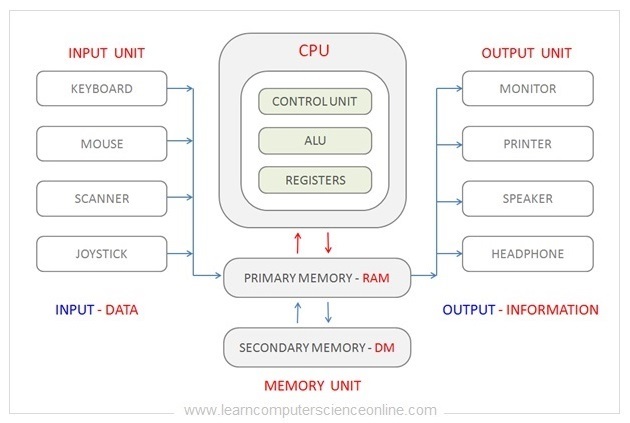
The introduction to computer system includes computer system organization and architecture and its technical features.
In this computer introduction you will also learn hardware components such as mother board , hard disk drive ( Disk Memory ), power unit, Central Processing Unit ( CPU ) also referred to as micro-processor, Random Access Memory ( RAM ) , computer buses , cooling fans and other hardware components.
Table Of Contents
What is computer .
- Features Of Computer System.
- Characteristics Of Computer.
- Components Of Computer.
- Functions Of Computer.
- Types Of Computer Systems.
- Computer. System Architecture.
- Computer. Block Diagram.
- Computer. Hardware.
- Computer. Software.
- Evolution Of Computer System.

Computer Definition
A Computer system is defined as a digital electronics device that can be programmed to accept some inputs in terms of data, then process this data as per the program instructions and provide the Output in the desired format that can be used for some meaningful work.

The computer user interacts with the system using an application software and provides the input data. The data is processed by the computer system with the help of application software.
The application software in turn interacts with the operating system and the processed data ( or we can call program output ) is then sent to the output device.
It is the application software that provides the instructions to the processor CPU to operate on the data as per the program instructions and produce the desired output.
The output device could be either a monitor, speaker, printer, storage device or any other output device.
Features Of The Computer System
- Computer System Is Programmable.
- Computer Accepts Raw Data And Produces Information.
- Computer System Is A Digital Machine.
Computer System Is Programmable
The computer system consist of both software components and hardware components. The hardware components are physical parts that we can touch and interact. Whereas, the software is essential to drive the hardware.
The computer program ( software ) is an essential component of every computer system which directs the computer to performs various tasks.
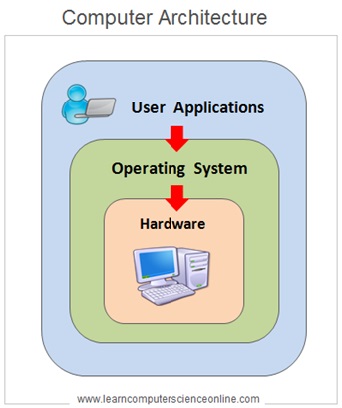
The Computer system is programmable. That means, the computer will perform the task only as per the program instructions.
The accuracy of the output depends upon the accuracy of the program instructions. The computer will produce wrong results if either input data or the program instructions are inaccurate. This is called garbage in and garbage out.
And therefore , the computer needs a program written in a programming language to execute a particular task on the computer system .
The Computer program directs the computer system through series of instructions. Each program instruction performs a specific part of the operation.
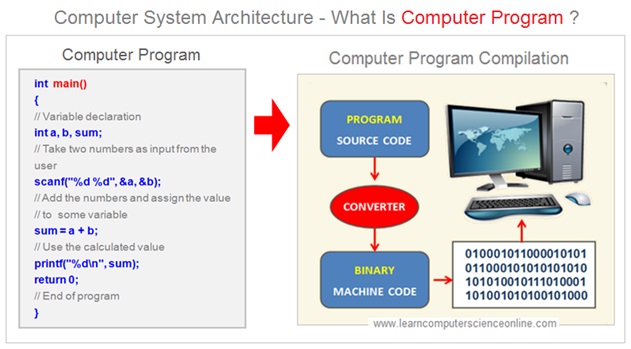
Functions Of Computer
Computers are now extensively used in every field we can possibly think of. Computers can handle simple tasks as well as highly complex tasks without any problem. Further, computer science is rapidly advancing both in terms of hardware and software.
A computer system is a complex combination of hardware and software that performs a multitude of functions. Computers can be programmed to handle everything from basic data processing to advanced applications across various domains.
It has become an integral part of modern life, impacting how we work, communicate, entertain, manufacture, and conduct research. In computer architecture , every computer performs four basic functions necessary for computer to work and execute the program instructions.
Four Functions Of Computer
- Input Function.
- Processing Function.
- Output Function.
- Storage Function.
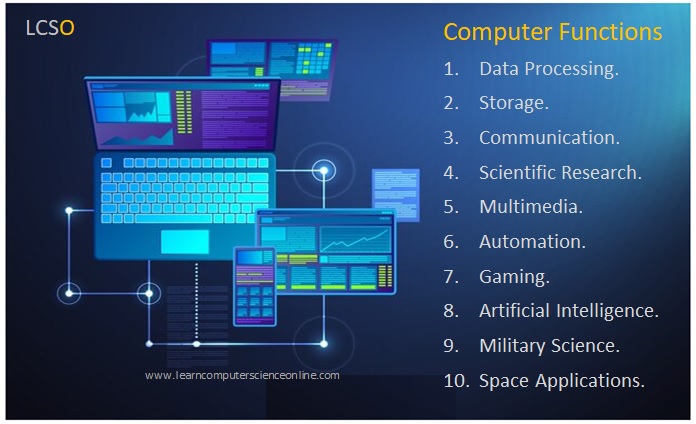
Applications Of Computer
- Data Processing: Computers can process vast amounts of data quickly and accurately. Computers can operate on data, perform calculations, sort information, and make decisions based on predefined algorithms.
- Storage: Computers can store data for immediate or long-term use. Computers are used to store and manage large volumes of data with the help of special software called Database Management System (DBMS). The DBMS can handle of types of data from text documents and images to software applications and multimedia files.
- Communication: Computers are essential for managing computer networks and communication, including email, messaging, video conferencing, and internet browsing.
- Multimedia: Computers are extensively used to create, edit, and play multimedia content, including audio, video, and images. Multimedia content is essential part of online education.
- Automation: Computers can control, manage and automate a wide range of processes, from industrial manufacturing, process management, to home appliances.
- Information Retrieval: They can access vast amounts of data, extract information and knowledge on the internet and retrieve specific data through search engines.
- Gaming: Computers are a popular platform for gaming, from simple browser games to virtual reality, 3D games with complex, graphics-intensive titles.
- Research and Analysis: R&D is essential part of development of modern technology and scientific research. They play a crucial role in scientific research, data analysis, and simulations for various fields.
- Creativity: Computers assist in graphic design, music composition, 3D modelling, and various creative endeavours.
What Is Computer Program ?
The software components are computer programs. The program consist of set of instructions that directs the computer system hardware components to perform the desired operations.
The computer programs are generally written using high level ( human readable ) programming language such as C , C++ , Java , Python and many more.
However, a high level programs are first required to be converted into low level ( machine code ) machine instructions in the binary. The machine instructions in binary at can be directly decoded and executed by the computer. This conversion is called program compilation.
The computer system interprets these program instructions and then performs the desired operations. The CPU executes the program instructions one by one.
The Computer Accepts Input And Provides Output
The computer converts raw data into information.
The Computer Systems are versatile machines and can be used to perform number of operations. The data processing is one of most common application of the computer.
For example, a company might use the computer system for managing employee records stored into the database , customer database, inventory management, billing, record keeping, payroll processing, accounting and many such applications.
In order to use the computer system for any database operations, a DBMS ( Database Management System ) software is required.
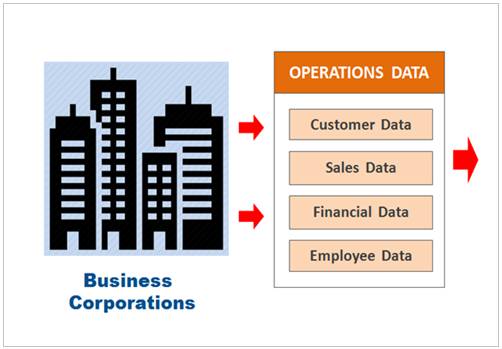
The computer system is also used to process the raw data and produce the information that can be used for some meaningful purpose.
The processed data is called information. And the information can be used for some meaningful work such as decision making within an organization.
Computer System Is A Digital Machine
The computer is a digital electronic machine. Which means, a computer can understand and execute instructions on in binary which consist of only two numbers that is zero 0 and one 1 . The binary code is also referred as machine code or machine language.
The computers central processing unit ( CPU ) is the brain of the computer system. The CPU is responsible to perform both arithmetical and logical operations.
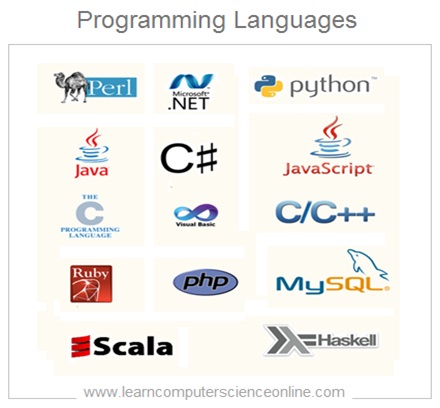
However , the computer’s micro-processor ( CPU ) can decode and execute instructions only in the machine code in Binary.
So, it doesn’t really matter in which programming language you write the program code because eventually, all high level computer programs must be first converted into low level machine code in binary . The machine instructions consist of only binary 0 and 1.
And therefore, all programs in high level are converted into low level machine instructions that can be directly executed by the microprocessor.
The conversion process to translate the high level program into low level machine code is called program compilation.
Why Computer Use Binary ?
Why computer understands binary 0 and 1 , characteristics of computer system.
The computers characteristics include automatic working, operating speed, accuracy of calculations, versatility, diligence, memory, program dependence and reliability of operational performance.
- Automatic Working.
- Operating Speed.
- Accuracy Of Calculation.
- Computer Is Versatile.
- Computer Is Diligent.
- Computer Has Memory.
- Computer Needs Program.
- Computer Is Reliable.
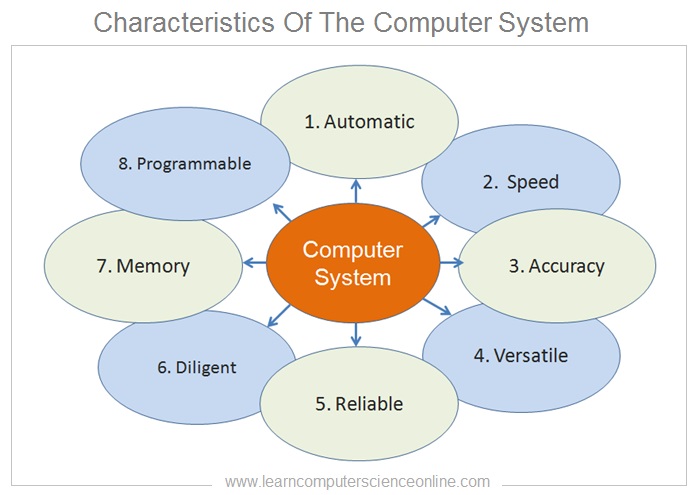
Automatic Working
The computers are extensively being used for automatic operations. The computer once programmed to perform some task can continue without any human intervention.
The artificial intelligence has further enhanced this capability for the computers. The computer can repetitively perform many operations in the automatic mode.
Operating Speed
The modern computers are armed with the latest microprocessor can execute billions of instructions within a fraction of a second. That gives huge processing power to the computer.
And therefore, the computer can be effectively used for performing complex operations with very high operating speed.
Accuracy Of Calculations
The computer can perform millions of complex calculations and take the logical decisions as per the program instructions with remarkable accuracy.
However, the accuracy also depends upon the accuracy of the program instructions and the input data. The computer will produce wrong result if there are any mistakes into the program instructions.
This is often referred to as “Garbage In Garbage Out” ( GIGO ).
Computer Is Versatile
The computer is a truly versatile machine that can be used for many applications. The use of computer is now an essential part of every industry and profession we can possibly think of.
Apart from its applications in academics , the computers are everywhere. The computers are used by the students , teachers , musicians , doctors , engineers , accountants , police , armed forces and architects.
Both large scale and small scale companies are dependent upon the computers to manage their business operations.
Computer Is Reliable
The computers are the most reliable machines to perform multiple tasks without any mistake with the lightening speed.
And therefore , the computerized operations are the backbone of all top business corporations , global ecommerce giants such as Amazon , Reliance and for other companies.
The computer system can also be programmed to enforce set of rules to ensure safety of the user and data security.
Computer Is Diligent
There are many business corporations and manufacturing companies that work day and night without any break. Such operations and production lines can be very well managed by the use of computers.
Depending upon the use, the computer hardware is specially tailor made to handle such prolonged operations.
Computer Has Memory
The computer system needs memory to store data and program instructions. The system memory consists of both short term ( RAM ) and long term memory. The business corporations need to handle large volumes of data. The data needs to be stored into the permanent storage devices for the future use.
The computer system with front end application software , a database management system ( DBMS ) and the database is essential to manage such large volumes of data.
For example, tech giants like Google, Facebook handle large volumes of data related of the millions of users across the globe.
Computer Needs Program
The program dependence is another important characteristics of the computer. The computer is often said to be a dumb machine without any IQ. And therefore, the computer needs a set of instructions called a program.
A computer program is an essential component of every computer system. Each task and operation performed by the computer is completed as per the program. The program consists of set of instructions that directs the computer.
The computer is not going to perform any task on its own unless it is directed by the computer program .
Components Of Computer System
The Computer system consist of four basic components Or functional Units. In terms of functionality, the computer system can be grouped in to four units.
The Computer System Components are :
- Input Devices ( Input Unit ) .
- CPU ( Central Processing Unit ) .
- System Memory ( Memory Unit ) .
- Output Devices ( Output Unit ) .
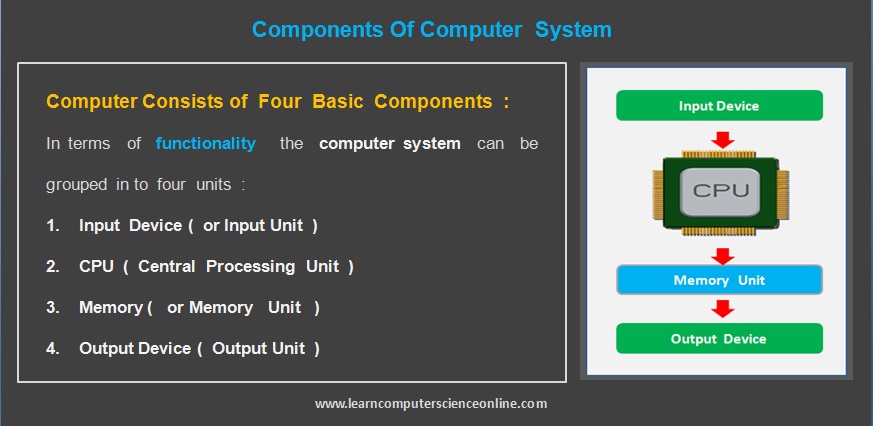
Input And Output Devises
Computer system input unit.
The term “Input Unit ” ( Input Devises ) refers to the input provided by the user by using any input device such as keyboard, mouse, mike, camera or any storage device in the form of input data.
The input data is operated and processed by the Central Processing Unit ( CPU ) as per the program and sent to the output unit for further action.
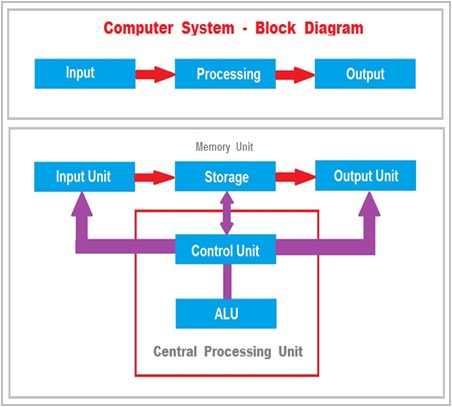
Computer System Output Unit
The term “Output Unit ” refers to the output provided by the computer CPU after processing the user data inputs .
This output is then sent to the output device such as monitor , printer , speaker to provide desired output to the user. The output can also be stored on any storage device for future use.
Computer System Memory Unit
The memory unit is an essential part of every computer system. The computer system needs memory to store the program instructions and the data before and after the processing.
The computer system memory unit consist of both temporary and permanent memory. The Random Access Memory ( RAM ) is the main memory where the operating loads the program for its execution.
The temporary memory RAM can store the data till the time the system is powered on . Whereas, the permanent memory ( disk memory ) can store the data even after the the system power is switched off.
Memory Hierarchy
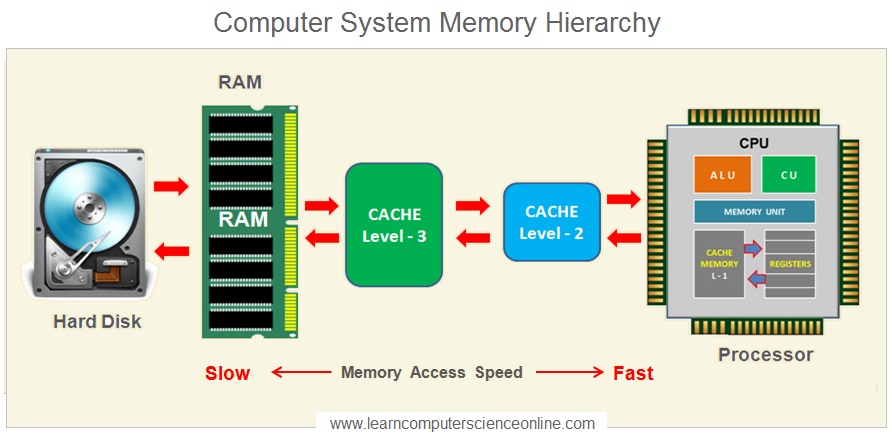
The computer system makes the use of different types of memories organized in a hierarchical manner and together they are referred as memory unit. The arrangement of different types of memories is referred as memory hierarchy.
The computer memory unit consist of different types of memories which differ in capacity, access speed, physical size and the cost of the memory.
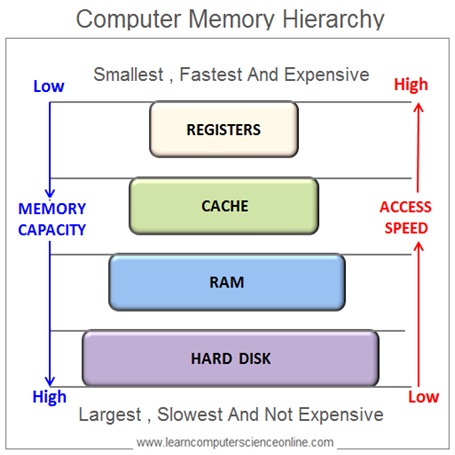
Primary Memory
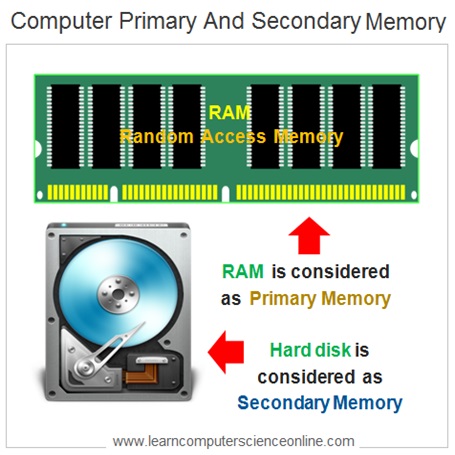
Each of the memory is optimally used in the computer system depending upon its access speed , size and proximity to the CPU .
The computer system makes use of different types memory depending upon the functional requirements .
The computer memory is mainly divided in to two types based on the data retention by the computer memory when power is switched off to the computer system.
Computer Memory Unit
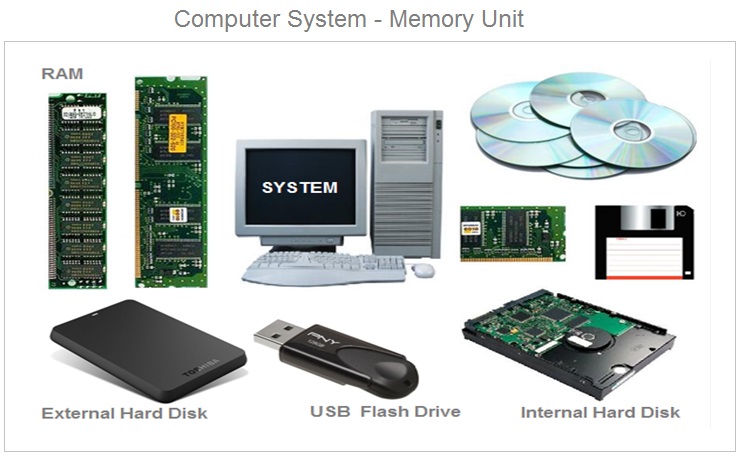
Computer System Memory
Temporary and permanent memory.
The computer memories can be grouped into two basic types depending upon the data retention by memory when system power supply is switched off .
If the memory retains the data without power supply, then it is referred as permanent memory . For example hard disk , pen drive are permanent memory ( Also referred as secondary memory ) .
The Random Access Memory ( RAM ) is the main system memory for a computer system . The RAM is a temporary memory because it retains the data only till the time , the system power supply is on.
The data in the RAM is lost once the system is switched off . And therefore main memory RAM is referred as temporary memory ( also referred as primary memory ).
- Program Execution.
- Accept Data From Input Device.
- Store Data And Program In Memory.
- Data Processing.
- Send Output To Output Device.
- Control All Operations.
Program Execution
The program execution is the main function of the computer system. The computer system makes use of its hardware and software components to execute the program.
Various components such as memory ( RAM ) , CPU , input devices , output devices performs different functions together during the program execution.
Accept The Data From Input Devices
The computer system operates on the data as per the program instructions. The computer accepts the data through different types of input devices such as mouse , keyboard scanner and other input devices.
Store Data And Program In Memory
The computer stores the data and the program into its main memory RAM. The program is stored into the memory as set of instructions.
The CPU starts the program execution by fetching the data and instructions from the memory . The CPU sends the processed data back to the memory for the output devices.
Data Processing
The computers are extensively used for data processing jobs. The process converting the raw data into useful information is defined as data processing.
The data is processed as per the program instructions. For example , the monthly attendance data is converted into salary statements at the end of the month by using a payroll application software.
Send Output To Output Device
The output devices are used to send the result that can used by the user. The program output can either be sent to the monitor , printer , storage disks or any other output device.
Control All Operations
The computer system controls the operations of the software and hardware components. The control unit of the CPU ( central processing unit ) controls the operations of the entire computer system .
Types Of Computer Systems
Different types of computer systems are used for various applications in many fields. The system configuration can differ in terms of processor architecture, number of processor, memory size, motherboard design and other factors.
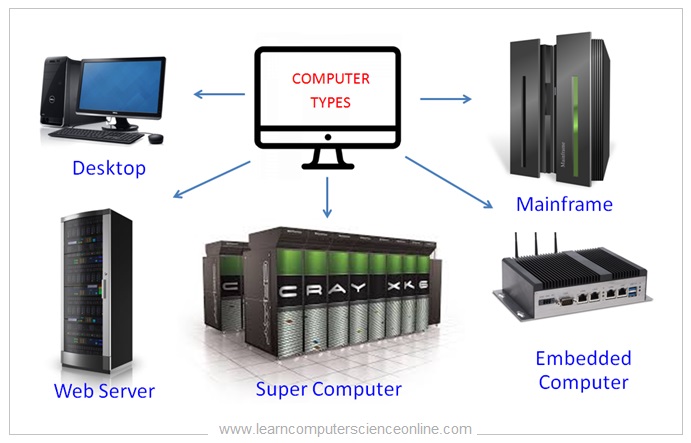
- Desktop Computer.
- Palmtop Computer.
- Workstation Computer.
- Web Server Computer.
- Mini Computer.
- Mainframe Computer.
- Super Computer.
- Embedded Computer.
Computer System Architecture
What is computer system architecture .
In computer engineering, the computer system architecture is the conceptual design and fundamental operational structure of a computer system.
It is the technical drawings and functional description of all design components and requirements . The system architecture defines the system performance parameters such as speed and interconnections .
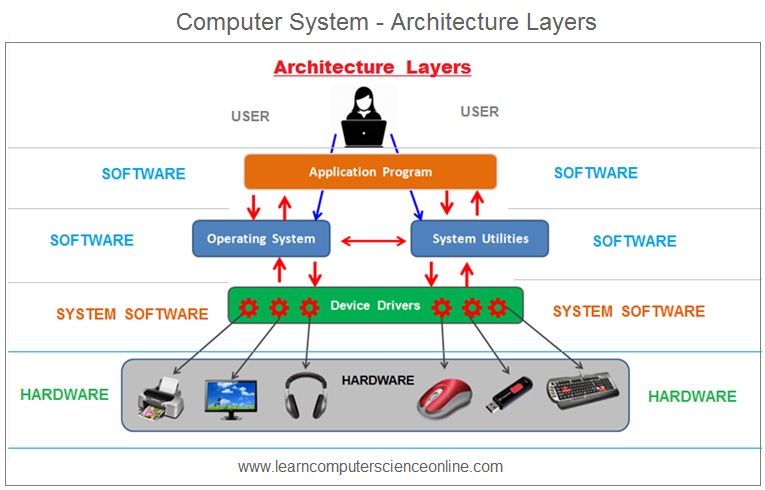
The System architecture can also be defined as the science and art of selecting and interconnecting hardware components to create computer system that meet functional , performance and cost goals.
And therefore , better system architecture will produce a better design and system performance.
Computer Organization And Architecture ( COA )
The Computer system consist of four basic components Or Units . In terms of functionality , the computer system can be grouped in to four basic units .
- Input Unit ( Input Devices ).
- Central Processing Unit ( CPU ) .
- System Memory Unit .
- Output Unit ( Output Devices ) .
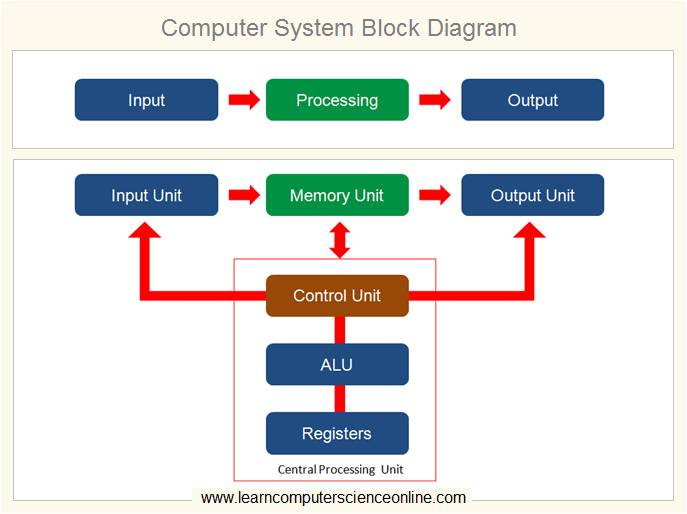
Computer Hardware
The computer system mainly consist of hardware components and the software components . All the physical components inside the computer cabinet and the input / output gadgets attached to the computer are referred as hardware components .
The hardware components inside the computer cabinet are referred as internal components such as motherboard .The external hardware components attached to the computer system are also referred as peripheral devices such as keyboard , mouse , monitor .
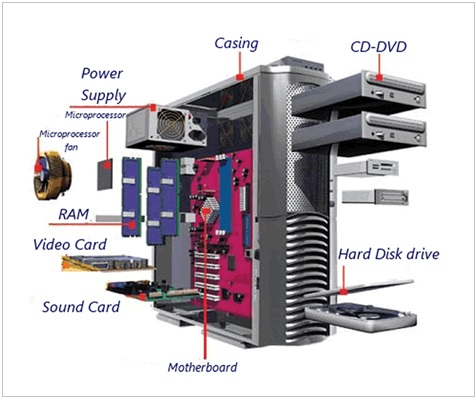
Computer Hardware Components
- Computer Cabinet ( Casing ).
- Power Supply Unit ( SMPS ).
- Motherboard .
- Connection Cables ( Buses ).
- Hard Disk ( Disk Memory ) .
- RAM Modules
- Sound Card.
- Microprocessor ( CPU ).
- CPU Heat Sink
- CPU Cooling Fan.
- CD ROM Drive.
- Graphics Card.
- Computer Monitor ( Display ).
- Keyboard And Mouse.
Computer System Motherboard
The motherboard is the main printed circuit board ( PCB ) that is mounted inside a computer cabinet. The motherboard is a junction for connecting some important internal components .
The components that are directly placed on the motherboard include microprocessor ( CPU ) , main memory RAM , Graphic card , sound card , north bridge and south bridge.
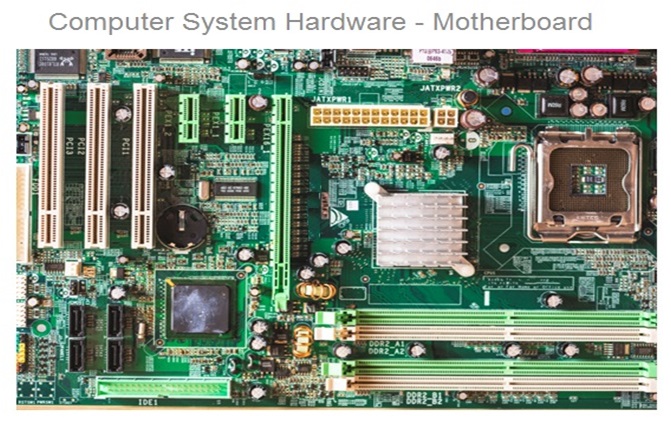
Computer System Microprocessor
The central process ring unit ( CPU ) effectively functions as a brain of the computer system. The CPU performs arithmetic and logical operations and provides processing power of the computer system.
The CPU is mounted on the motherboard inside a processor socket which is a special slot present on the motherboard. The processor chip is firmly mounted inside CPU socket with help of liver locking mechanism.
A heat sink and a cooling miniature fan is placed on the top of the processor chip to protect the processor chip from excessive heat generated by the processor chip.
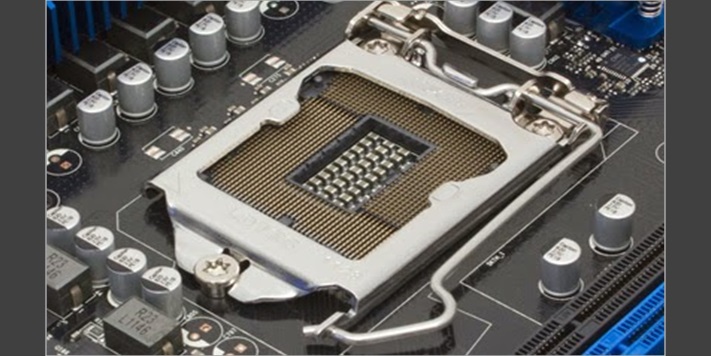
What Is Microprocessor ?
What is cpu , how cpu works , cpu functions.
The central processing unit ( CPU ) is also alternately referred to as microprocessor or processor . The processor provides the processing power to the computer system .
The CPU performs number of vital functions . One of the the main function of the CPU is to execute the computer program.
The control unit of the CPU is responsible to decode the machine instructions. The control unit decodes the program instructions as specified in the instruction format.
The CPU executes the computer program by repetitively performing a machine cycle which is a basic operation of the processor . The machine cycle consist of four steps . These machine cycle steps are :
What Is Central Processing Unit ?
What is cpu machine cycle .
The operating system loads the program instructions and associated data into the main system memory RAM . The CPU fetches the data and program instructions ( machine instructions ) from the main memory RAM .
Main System Memory
Random Access Memory ( RAM )
The computer system makes use of different types of memories . These different types of memories are organized into the system in order to optimize the CPU performance.
The main system memory RAM ( Random Access Memory ) modules are mounted inside special RAM slots on the motherboard . Each motherboard has fixed number of RAM slots .
The maximum permissible RAM size ( 4 GB , 8GB , 16 GB ) supported by the system depends upon the system configuration and the type operating system ( 32 Bit OR 64 Bit OS ).
System - Power Supply Unit
The computer system has a centralized power supply unit that provides electrical power supply to various internal components .
The desktop computer system power system is referred as SMPS which stands for Switched Mode Power Supply . The SMPS provides different voltage of power supply to different components through set of electric wires.
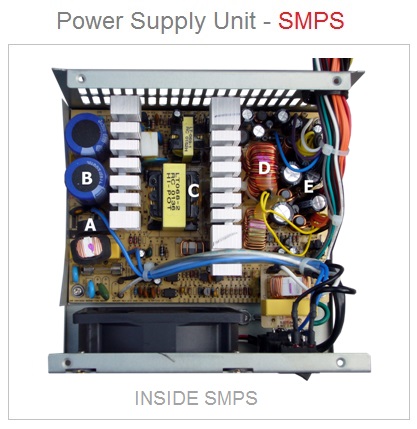
Computer Software
The computer software is a set program instructions designed to perform a specific tasks . A computer program is written in computer programming language such as C , C++ , Java , python and so many other languages .
The computer system makes use of two types of software .
- System Software .
- Application Software .
The System software is used by the system itself manage and control the system hardware components. The operating system communicates with the hardware components through system software .
The System software includes Operating System ( OS ) ,device drivers and other system utility programs . The application software are used by the computer user to perform various tasks on the system. The commonly used application software includes MS Word , Excel .
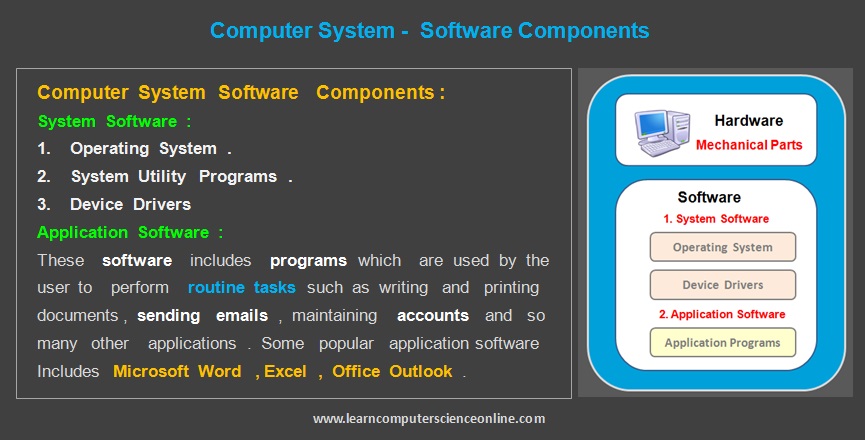
System Software
What is system software .
In computer system architecture , the System Software is a collection of programs designed to operate , control and extend the processing capabilities of the computer system and the other hardware devices connected to the computer system.
The system software is also designed and developed by the computer manufacturer to communicate with specific hardware components connected to the computer system.
For example when we connect a new device to the system , we need to first install the device driver to operate the device such as camera , printer , scanner and other such devices .
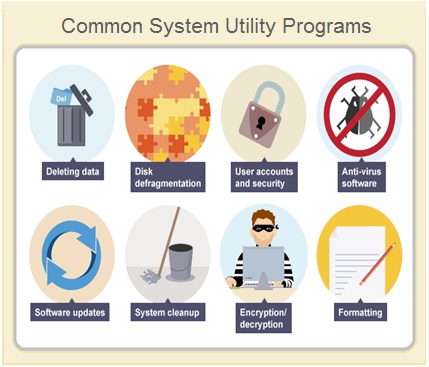
Both application programs and the operating system needs a special software called device driver to communicate and to drive the various hardware components connected to the computer system .
The device driver is a system software which functions as an interface between the computer hardware and the operating system .
The system software programs are generally written in a low level programming language such as assembly language .
Application Software
The application software provides an interface to the computer user to perform a specific job on the computer system . For example , writing document , making presentation or managing accounts .
Application software are installed on the system to provide specific functionality to the system . The Application software is designed and developed to satisfy a specific need of the computer user .
For example MS Office , accounting software ( Tally ) , engineering drawing software ( AutoCAD ) are some of commonly used application software.
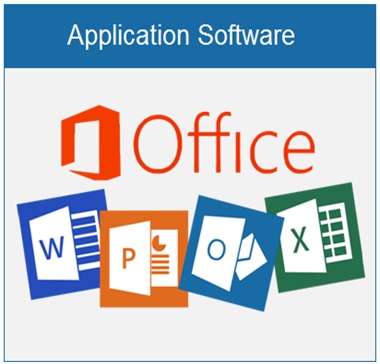
Application software can be single program application or a group of programs bundled together such as MS Office . Each of these program in a bundle has been designed to provide specific functionality to the user .
Evolution Of Computers
The Computers are today integral part of the human world and human world today critically depends upon the computing power of today’s modern computers .
The applications of computers are indispensable part of every industry we can possibly think of .
The Computer Science and technology has also evolved over period of last few decades both in the hardware technology and also in the software domain.
However , The history of computer science began , long before our today’s modern discipline of computer science.
In the past seventy years , the computers have evolved from room-size mega boxes to the desktops computers. And now, computers are in our pockets with far more computing power and mobility.
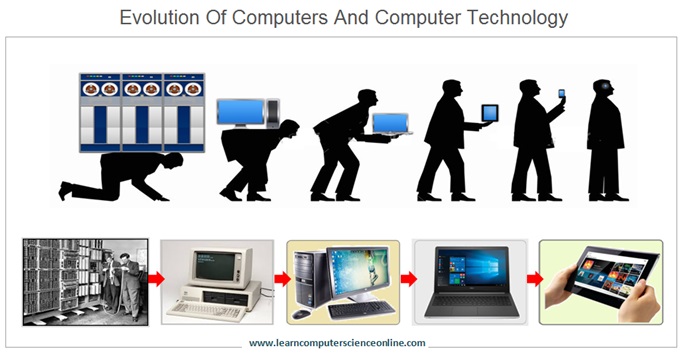
But the modern computing-machine era began with Alan Turing’s conception of the Turing Machine, and the invention of the transistor by three Bell Labs scientists.
The invention of transistor was a major breakthrough in the field of digital electronics . The transistor is tiny electronic component that used as a micro-switch in digital electronics .
The transistors soon replaced the bulky voles valves used in the second generation of computers. The transistors are fundamental building block of all modern processor chips .
Turing Machine
The turing machine is an important mathematical computation model in the theory of computing . Although this model was first proposed and invented by Alan Turing in year 1936 .
The turing machine model is still considered to be a standard of computational model to verify a particular problem can be solved using a computer system .
Turing machine is still relevant despite the passage of time and the advancements in the various fields of computer science . Despite the simplicity of the model , the turing machine can simulate both simple and a very complex algorithm.
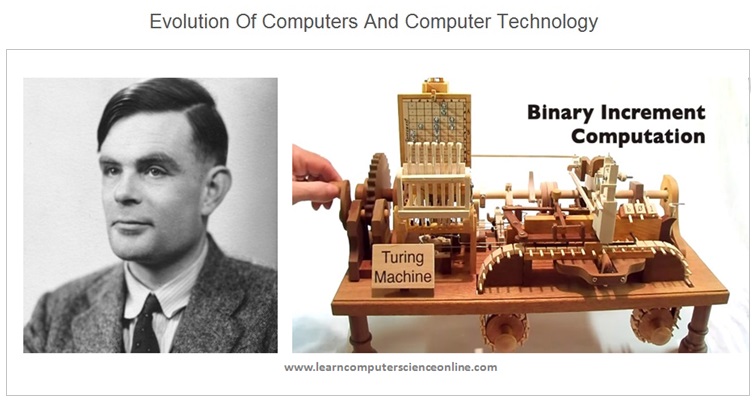
Computer Architecture
The CPU is the brain of the computer system which performs all the mathematical calculations and logical operations . The CPU consist of millions of tiny components called the transistor.
The transistor functions as a micro switch that can be simulate the two binary states ( 0 and 1 ) .
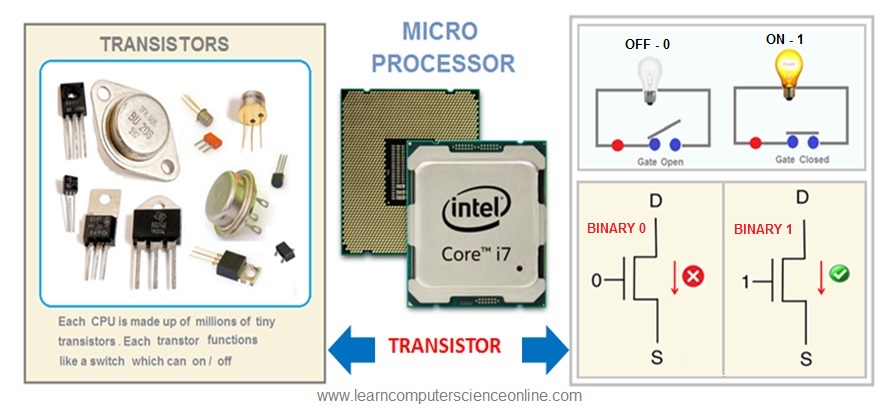
The transistors are made-up of semiconductor material silicon. The transistor can easily functions as micro-switch to represent the two states ( ON – 1 And OFF – 0 ) in binary . The transistor is a fundamental building block for all digital electronic devices including computers .
The invention of tiny electronic component transistor was a major technological leap forward that has made the modern-style computing possible today .
The invention of transistor was an important milestone in field of digital electronics which rewarded the three Bell lab scientists with the 1956 Nobel Prize in Physics . The Microprocessor consist of millions of these transistors.
Introduction To Computer FAQ
A computer is a digital electronic machine used to convert data into information. The computer will process the data as per the computer program instructions.
This is the most common application of the computer. A computer is also defined as programmable electronic machine used for data processing.
Computer Block Diagram
What Is Computer Software And Hardware ?
A computer system consists of software and hardware components. The software components are basically computer programs. Whereas, the hardware components are physical parts of the computer. Both hardware and software together forms a computer.
A computer is driven by a set of instructions which directs the computer to perform some specific tasks. This set of instructions is called a computer program.
A computer programs are written using a programming language. Different types of programming languages are used to write the program depending upon the application.
What Is Application Program ?
The application program is a type of computer program developed to allow the user to perform a specific task on the computer. For example, the user might need a calculator program to perform some calculations.
Similarly, the user use media player program to watch movies or to play some music on the computer. Microsoft word, PowerPoint, and excel are the most commonly used application program examples.
A system software is a type of computer program internally used by the computer to manage the computer. The user generally interacts with the application programs.
Whereas, different types of system software are internally used by the computer to interact and communicate with various hardware components connected to the computer.
What is the main function of the computer ?
The main function of the computer is to execute the program. Computer is also said to be a dumb machine because it needs a program to execute the various user specified tasks.
What Is Operating System ?
An operating system is a type of system software and essential component of every computer system. The operating system provides an interface to the user to interact and perform various tasks on the computer.
The operating system is also responsible to manage some of the most important functions such system security, resource management, manage hardware components and user permissions.
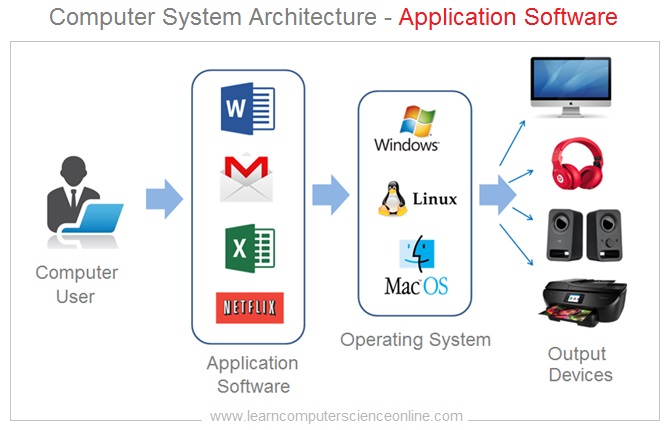
Join The Best Seller
Computer Science Online Course
Learn computer science and programming fundamentals.
This is the most comprehensive and unique C omputer Science And Programming Fundamentals course Online which will give you in depth understanding of most important fundamental concepts in computer science And Programming .
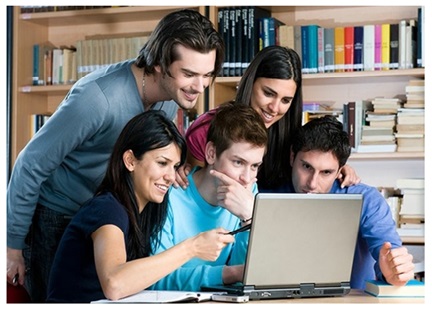
Other Related Topics
How computer works .
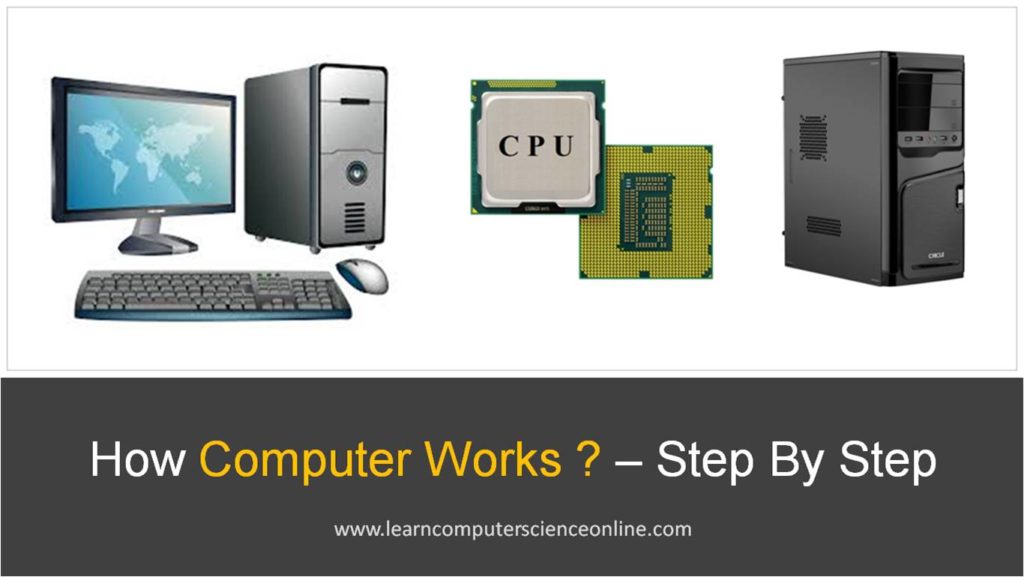
What Is Computer Hardware ?
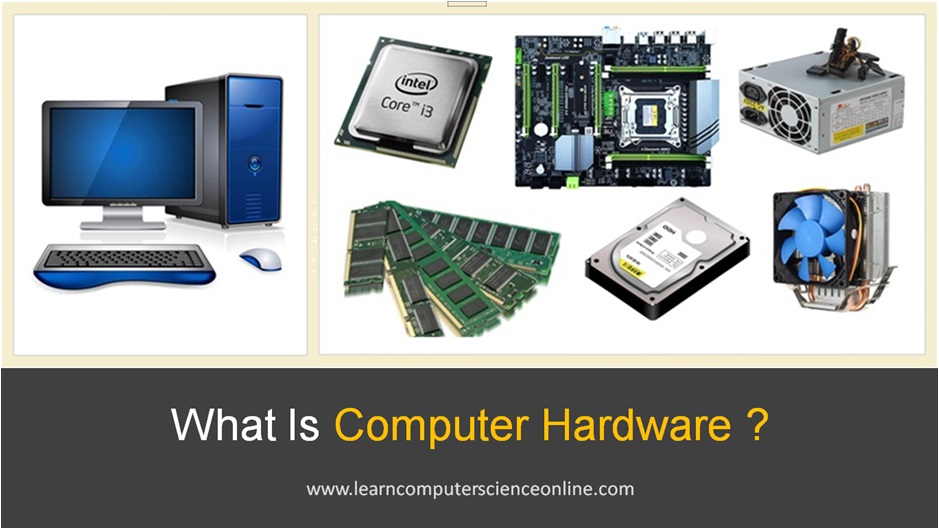

- My presentations
Auth with social network:
Download presentation
We think you have liked this presentation. If you wish to download it, please recommend it to your friends in any social system. Share buttons are a little bit lower. Thank you!
Presentation is loading. Please wait.
Chapter 1: Introduction to Computer
Published by Rudy Brewer Modified over 9 years ago
Similar presentations
Presentation on theme: "Chapter 1: Introduction to Computer"— Presentation transcript:

How Much Do I Remember? Are you ready to play.....

Basic Computer Vocabulary

Computer Skills Preparatory Year Presented by:

Computer Basics Whats that thingamagige?. Parts of a computer.

Chapter 1:Introduction to the world of computers

McGraw-Hill/Irwin ©2008 The McGraw-Hill Companies, All Rights Reserved Plug-in B3 HARDWARE & SOFTWARE.

1 Jordan University of Science & Technology Faculty of Computer & Information Technology Department of Computer Science & Information Systems cs98.

An Overview of the Computer System

Hardware. Basic Computer System Central Processing Unit Input Devices Output Devices Backing Storage Devices.

Introduction to Computers

Computer Systems – Hardware

What Is A Computer System?

1 Hardware - devices for Input. 2 Hardware - devices for Input Processing.

1 System Software “Background software”, manages the computer’s internal resources.

1 Introduction to Computers Prof. Sokol Computer and Information Science Brooklyn College.

Computer Parts There are many parts that work together to make a computer work.

Introduction to Computers Essential Understanding of Computers and Computer Operations.

MIS 175 Spring Learning Objectives When you finish this chapter, you will: –Recognize major components of an electronic computer. –Understand how.

Computer Skills CIS-100 CH 1.
About project
© 2024 SlidePlayer.com Inc. All rights reserved.

- Get started with computers
- Learn Microsoft Office
- Apply for a job
- Improve my work skills
- Design nice-looking docs
- Getting Started
- Smartphones & Tablets
- Typing Tutorial
- Online Learning
- Basic Internet Skills
- Online Safety
- Social Media
- Zoom Basics
- Google Docs
- Google Sheets
- Career Planning
- Resume Writing
- Cover Letters
- Job Search and Networking
- Business Communication
- Entrepreneurship 101
- Careers without College
- Job Hunt for Today
- 3D Printing
- Freelancing 101
- Personal Finance
- Sharing Economy
- Decision-Making
- Graphic Design
- Photography
- Image Editing
- Learning WordPress
- Language Learning
- Critical Thinking
- For Educators
- Translations
- Staff Picks
- English expand_more expand_less
Computer Basics - What is a Computer?
Computer basics -, what is a computer, computer basics what is a computer.

Computer Basics: What is a Computer?
Lesson 2: what is a computer.
/en/computerbasics/about-this-tutorial/content/
What is a computer?
A computer is an electronic device that manipulates information, or data. It has the ability to store , retrieve , and process data. You may already know that you can use a computer to type documents , send email , play games , and browse the Web . You can also use it to edit or create spreadsheets , presentations , and even videos .
Watch the video below to learn about different types of computers.
Looking for the old version of this video? You can still view it here .
Hardware vs. software
Before we talk about different types of computers, let's talk about two things all computers have in common: hardware and software .
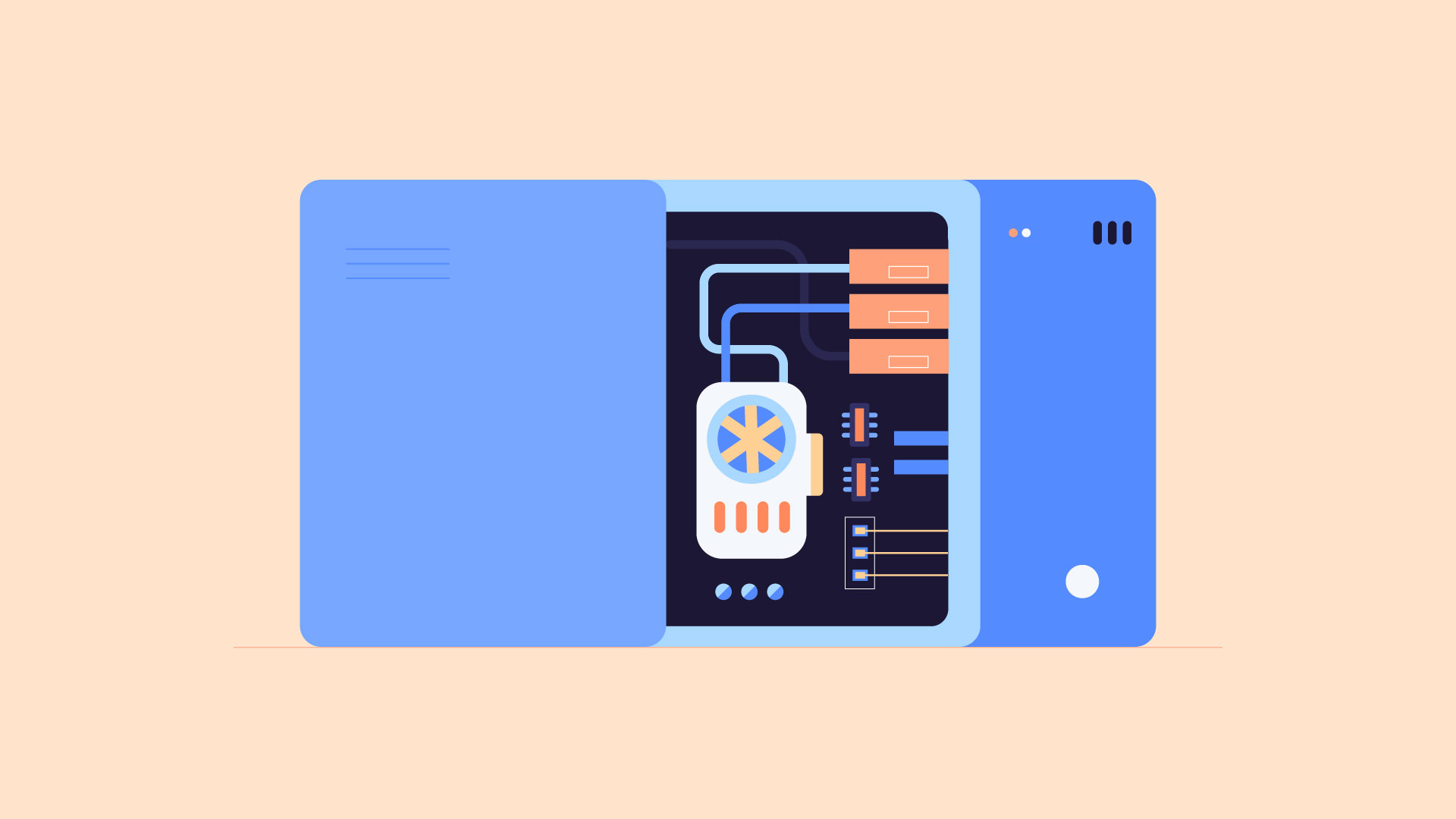
Everything you do on your computer will rely on both hardware and software. For example, right now you may be viewing this lesson in a web browser (software) and using your mouse (hardware) to click from page to page. As you learn about different types of computers, ask yourself about the differences in their hardware. As you progress through this tutorial, you'll see that different types of computers also often use different types of software.
What are the different types of computers?
When most people hear the word computer , they think of a personal computer such as a desktop or laptop . However, computers come in many shapes and sizes, and they perform many different functions in our daily lives. When you withdraw cash from an ATM, scan groceries at the store, or use a calculator, you're using a type of computer.
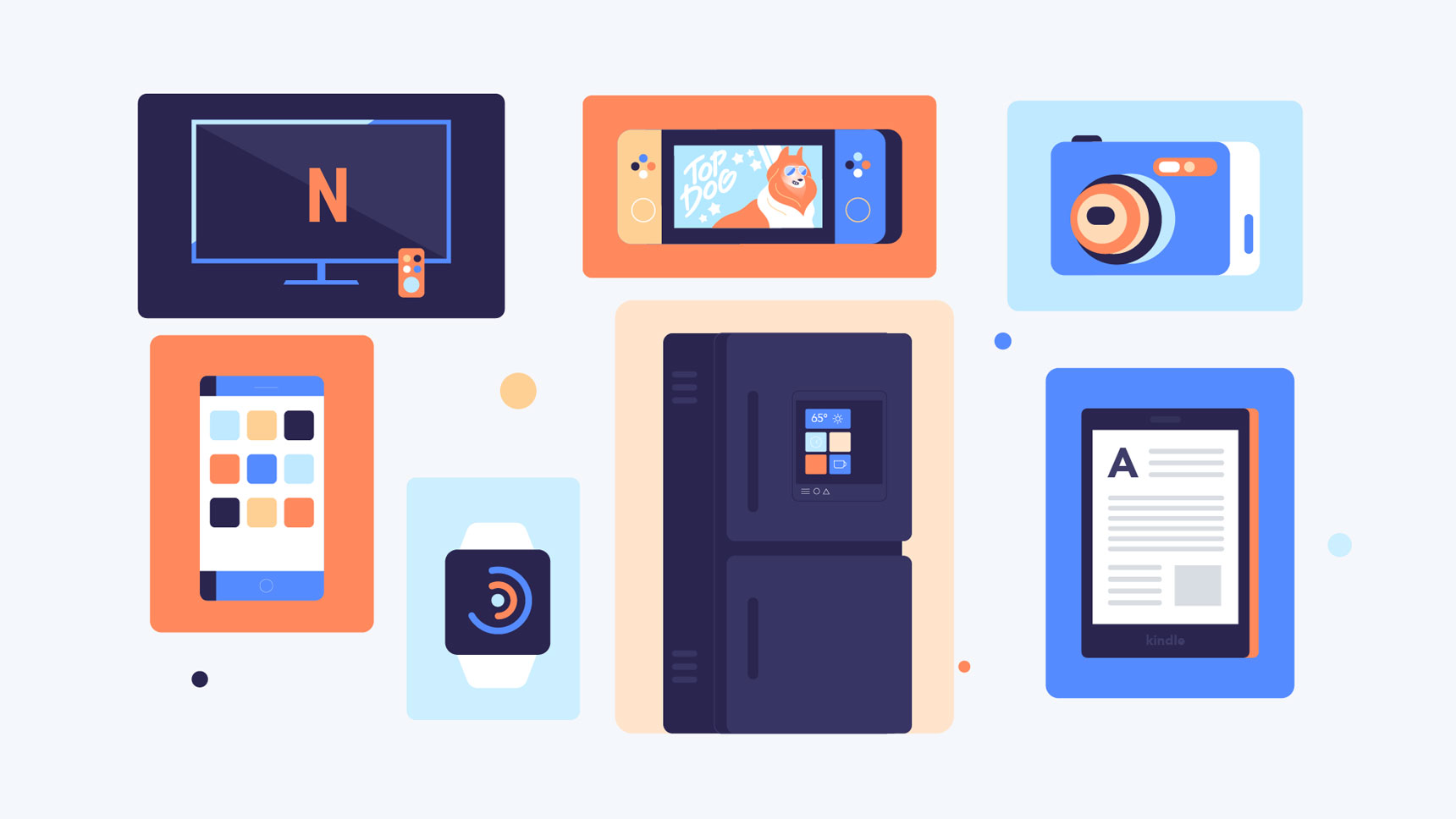
Desktop computers

Many people use desktop computers at work, home, and school. Desktop computers are designed to be placed on a desk, and they're typically made up of a few different parts, including the computer case , monitor , keyboard , and mouse .

Laptop computers
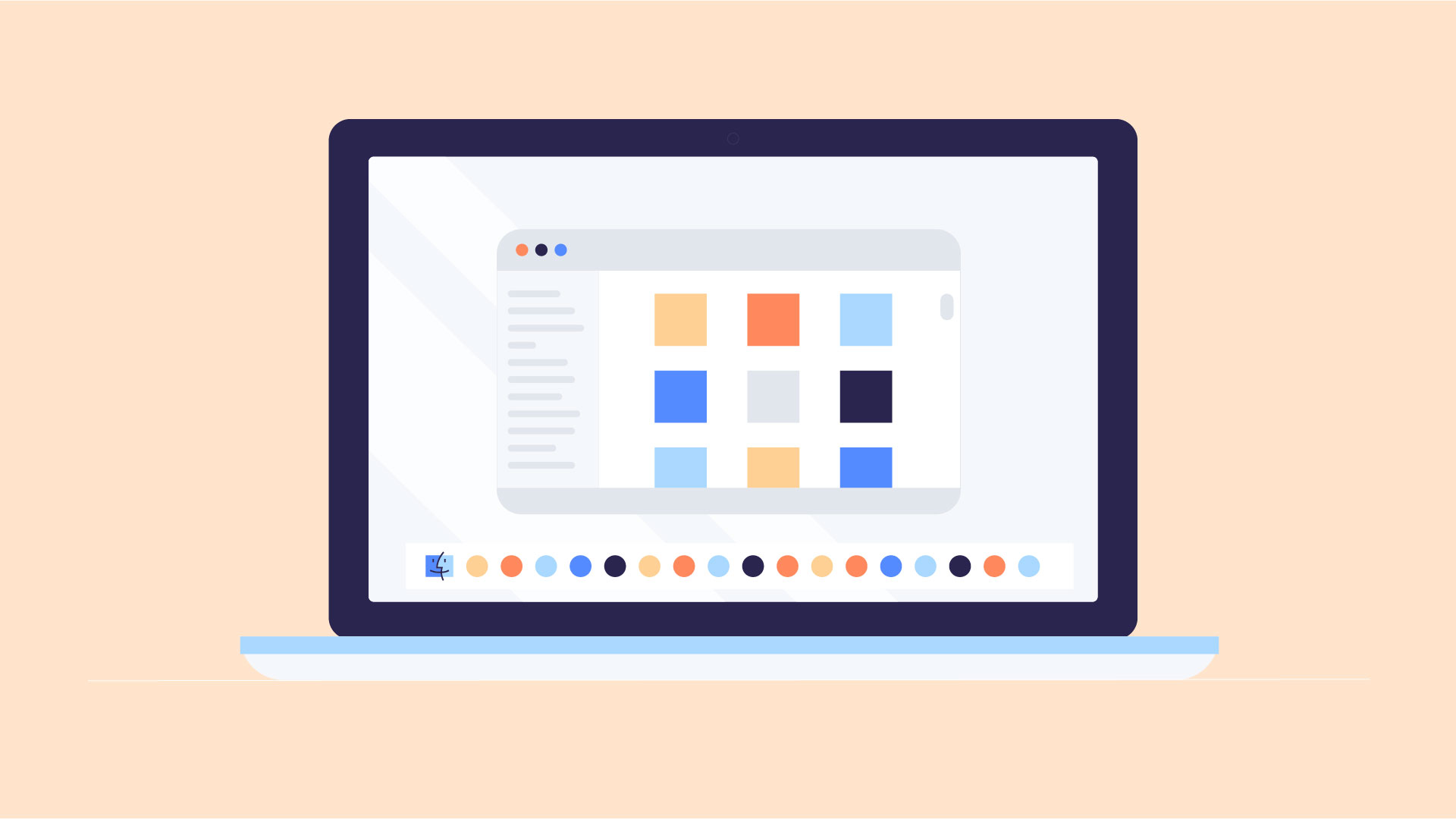
The second type of computer you may be familiar with is a laptop computer , commonly called a laptop. Laptops are battery-powered computers that are more portable than desktops, allowing you to use them almost anywhere.
Tablet computers
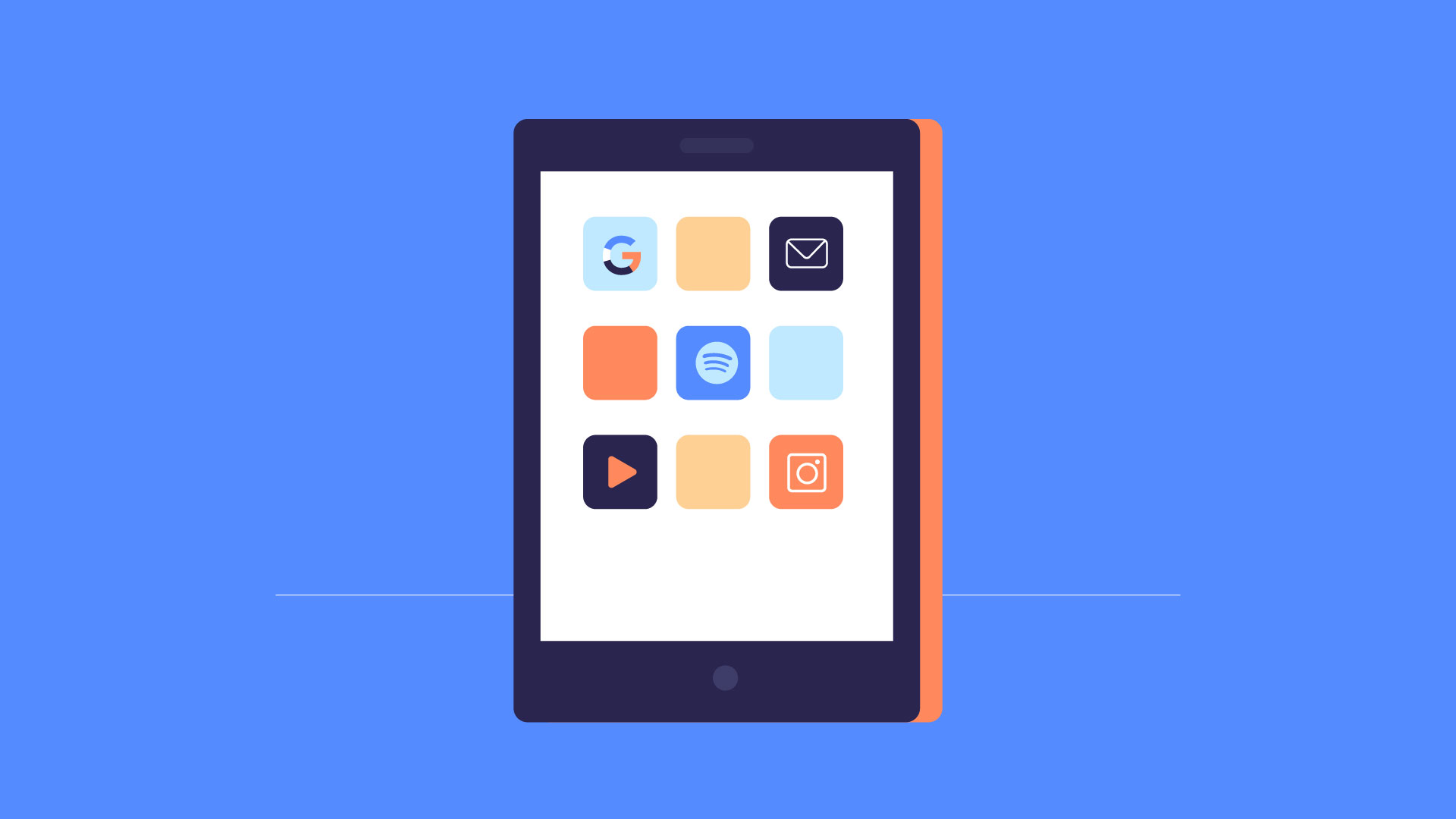
Tablet computers —or tablets —are handheld computers that are even more portable than laptops. Instead of a keyboard and mouse, tablets use a touch-sensitive screen for typing and navigation. The iPad is an example of a tablet.
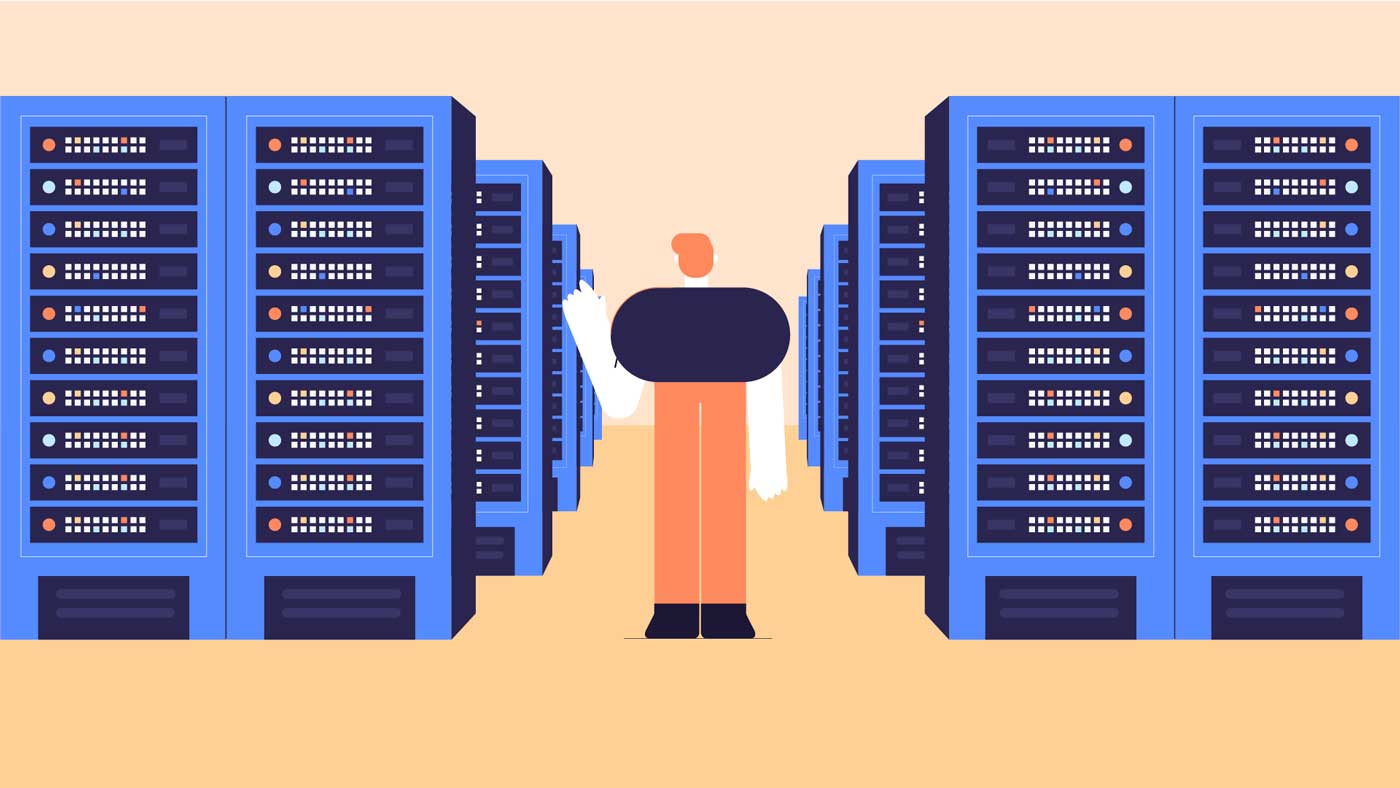
A server is a computer that serves up information to other computers on a network. For example, whenever you use the Internet, you're looking at something that's stored on a server. Many businesses also use local file servers to store and share files internally.
Other types of computers
Many of today's electronics are basically specialized computers , though we don't always think of them that way. Here are a few common examples.
- Smartphones : Many cell phones can do a lot of things computers can do, including browsing the Internet and playing games. They are often called smartphones .
- Wearables : Wearable technology is a general term for a group of devices —including fitness trackers and smartwatches —that are designed to be worn throughout the day. These devices are often called wearables for short.
- Game consoles : A game console is a specialized type of computer that is used for playing video games on your TV.
- TVs : Many TVs now include applications —or apps —that let you access various types of online content. For example, you can stream video from the Internet directly onto your TV.
PCs and Macs
Personal computers come in two main styles: PC and Mac . Both are fully functional, but they have a different look and feel, and many people prefer one or the other.
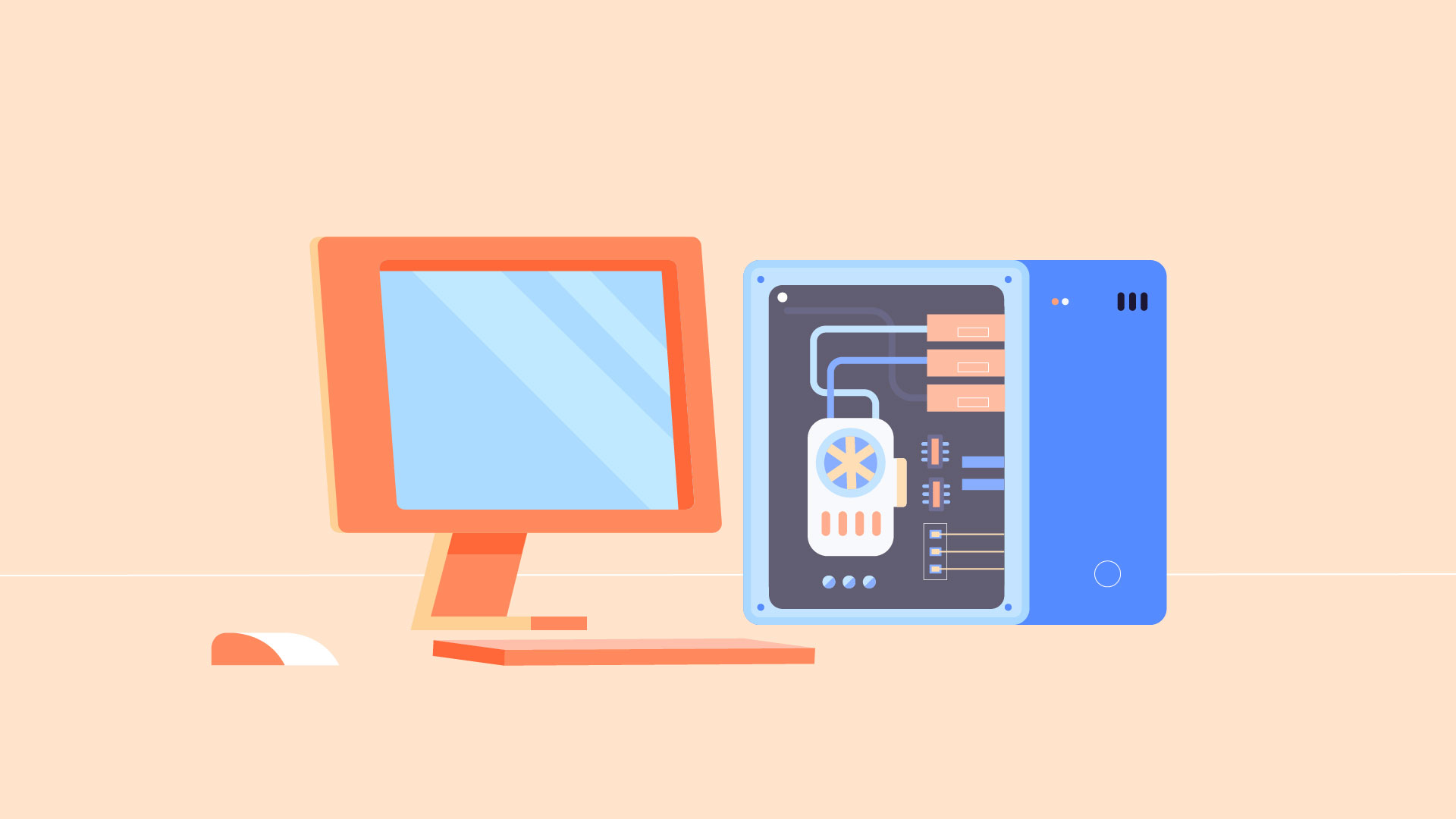
This type of computer began with the original IBM PC that was introduced in 1981. Other companies began creating similar computers, which were called IBM PC Compatible (often shortened to PC ). Today, this is the most common type of personal computer, and it typically includes the Microsoft Windows operating system.

The Macintosh computer was introduced in 1984, and it was the first widely sold personal computer with a graphical user interface, or GUI (pronounced gooey ). All Macs are made by one company ( Apple ), and they almost always use the Mac OS X operating system.
/en/computerbasics/basic-parts-of-a-computer/content/
Home Collections Geometry Computer Infographics Components Of A Computer System Ppt
Components of a Computer System PPT and Google Slides
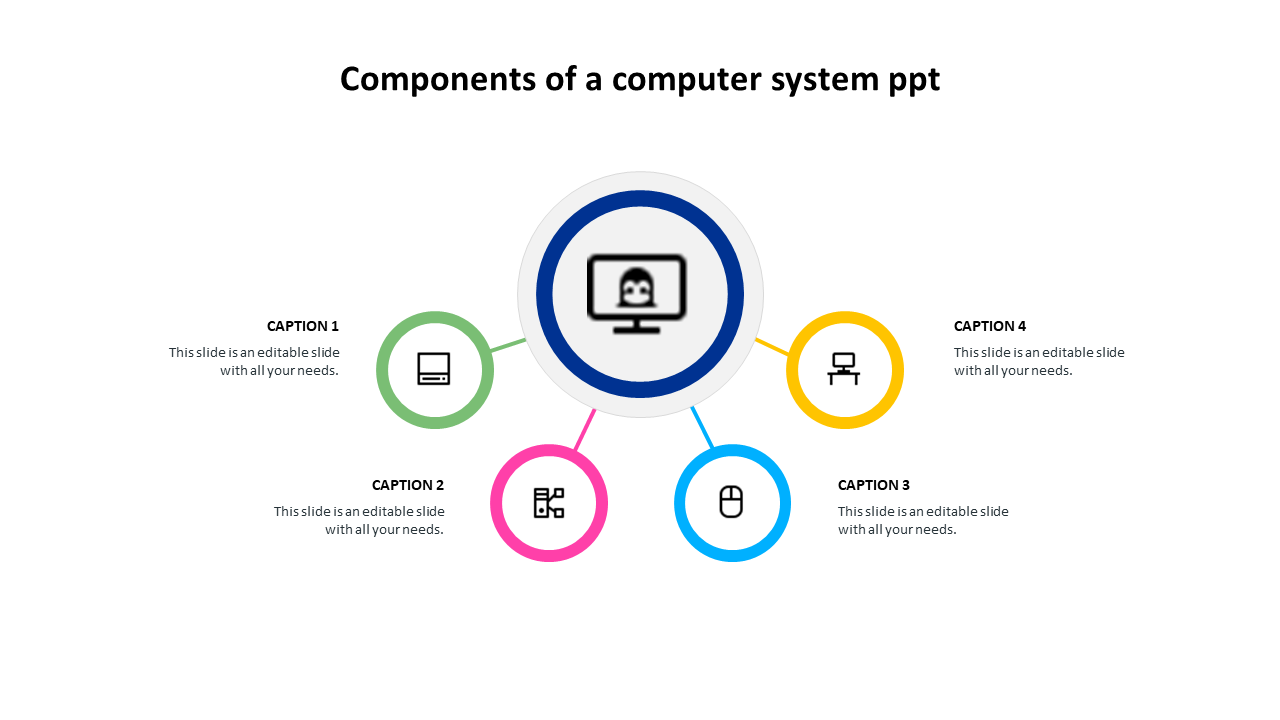
Components of a Computer System
Features of the template:.
- The slide are 100% customizable.
- The slide is contained in 16:9 and 4:3 formats.
- Highly compatible with PowerPoint and Google Slides.
- Easy to change the slide's colors.
- This slide has a colorful design pattern.
- computer infographics
- circle diagrams
- Component of Computer System
- Computer Fundamedals
- Basics Of Computer
- Computer Design
- Computer Frame
- Computer Technology
- Computer Screen
- Computer System
- Four Options
- Google Slides
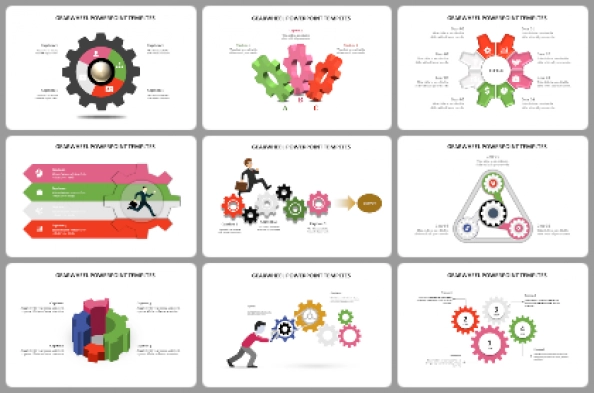
447+ Templates
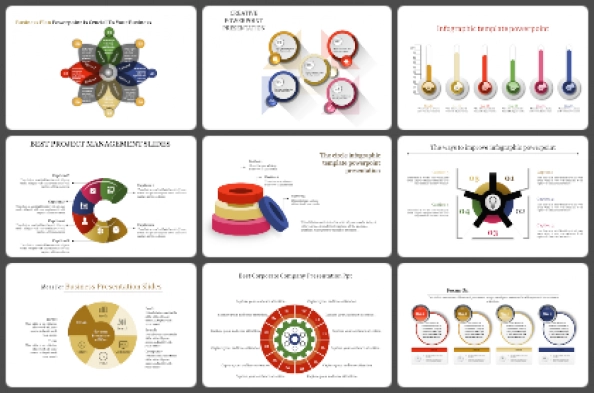
Non Circular
148+ Templates
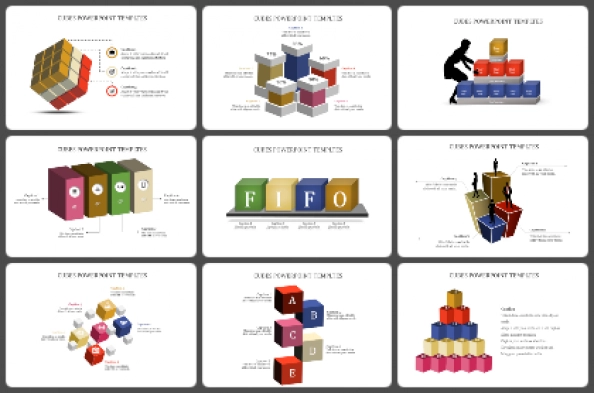
303+ Templates
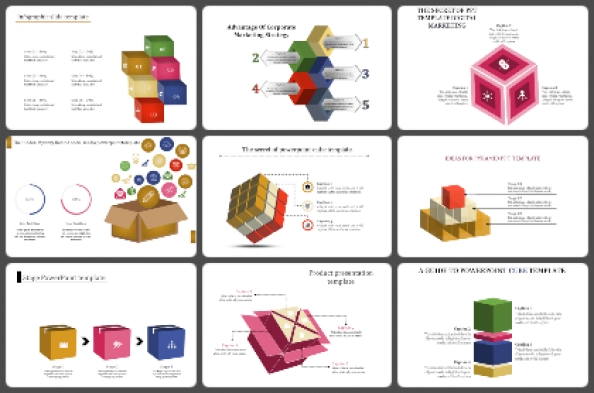
76+ Templates
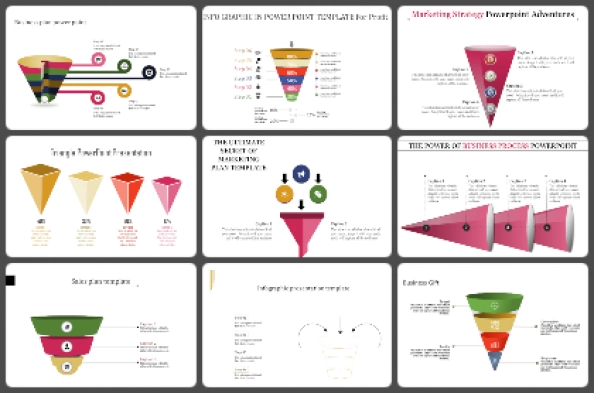
51+ Templates
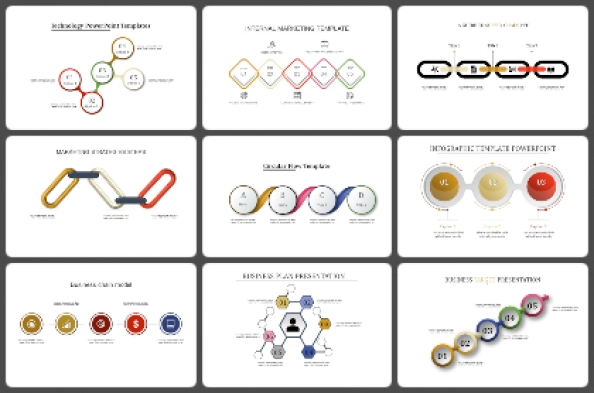
67+ Templates
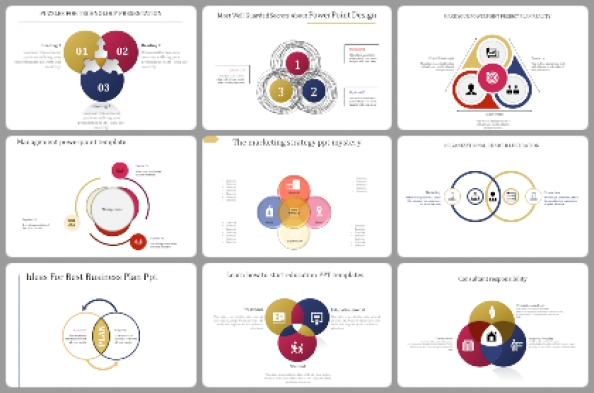
275+ Templates
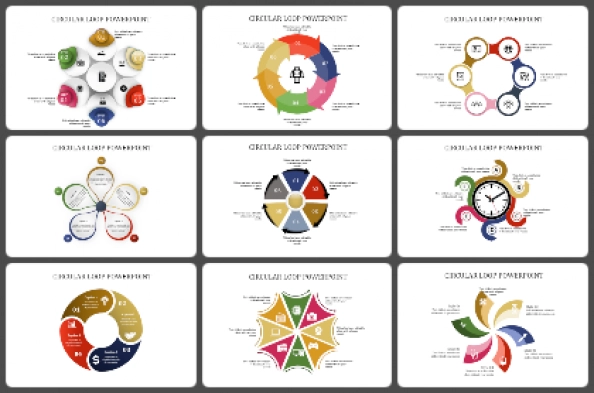
186+ Templates
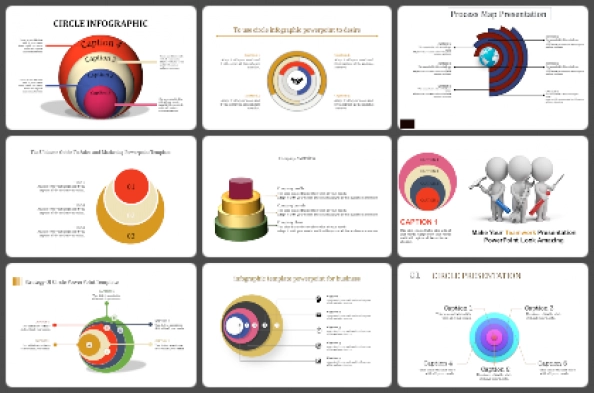
46+ Templates

20+ Templates
You May Also Like These PowerPoint Templates

Academia.edu no longer supports Internet Explorer.
To browse Academia.edu and the wider internet faster and more securely, please take a few seconds to upgrade your browser .
Enter the email address you signed up with and we'll email you a reset link.
- We're Hiring!
- Help Center
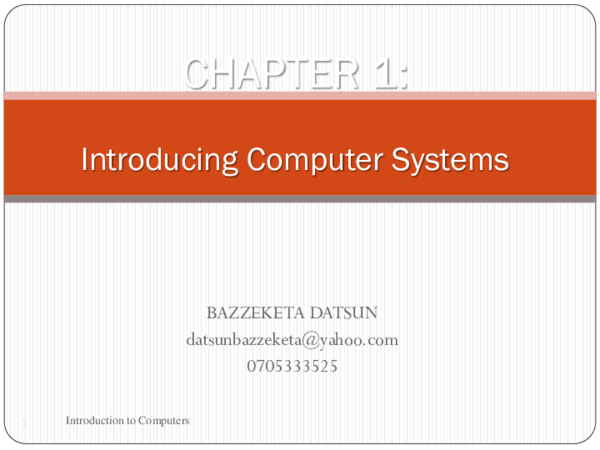
lesson 1-Introduction to computers.pptx

Related Papers
chitra devi
Kinoti Kaburuki
G G Rajput Rajput
SUBHAJIT PANDA
Computer, any of a class of devices capable of solving problems by processing information in discrete form. It operates on data, including magnitudes, letters, and symbols, that are expressed in binary code — i.e., using only the two digits 0 and 1. By counting, comparing, and manipulating these digits or their combinations according to a set of instructions held in its memory, a digital computer can perform such tasks as to control industrial processes and regulate the operations of machines; analyze and organize vast amounts of business data; and simulate the behaviour of dynamic systems (e.g., global weather patterns and chemical reactions) in scientific research. A typical computer system has four basic functional elements : (1) Input-output equipment, (2) Main memory, (3) Control unit, and (4) Arithmetic-logic unit.
Mahendra Pratap
Emma Greening
THE CENTRAL PROCESSING UNIT & OPERATING SYSTEMS
Santino Madut Uchalla
Subhash shetty
A computer is a device that can be instructed to carry out arbitrary sequences of arithmetic or logical operations automatically. The ability of computers to follow generalized sets of operations, called programs, enables them to perform an extremely wide range of tasks. Such computers are used as control systems for a very wide variety of industrial and consumer devices. This includes simple special purpose devices like microwave ovens and remote controls , factory devices such as industrial robots and computer assisted design, but also in general purpose devices like personal computers and mobile devices such as smartphones. The Internet is run on computers and it connects millions of other computers. Since ancient times, simple manual devices like the abacus aided people in doing calculations. Early in the Industrial Revolution, some mechanical devices were built to automate long tedious tasks, such as guiding patterns for looms. More sophisticated electrical machines did specialized analog calculations in the early 20th century. The first digital electronic calculating machines were developed during World War II. The speed, power, and versatility of computers has increased continuously and dramatically since then. Conventionally, a modern computer consists of at least one processing element, typically a central processing unit (CPU), and some form of memory. The processing element carries out arithmetic and logical operations, and a sequencing and control unit can change the order of operations in response to stored information. Peripheral devices include input devices (keyboards, mice, joystick, etc.), output devices (monitor screens, printers, etc.), and input/output devices that perform both functions (e.g., the 2000s-era touchscreen). Peripheral devices allow information to be retrieved from an external source and they enable the result of operations to be saved and retrieved.- source = Wekipeda
osheen sharma
The central processing unit (CPU, occasionally central processor unit) is the hardware within a computer system which carries out the instructions of a computer program by performing the basic arithmetical, logical, and input/output operations of the system. The term has been in use in the computer industry at least since the early 1960s. The form, design, and implementation of CPUs have changed over the course of their history, but their fundamental operation remains much the same. A computer as shown below performs basically five major operations or functions irrespective of their size and make. These are 1) it accepts data or instructions by way of input, 2) it stores data, 3) it can process data as required by the user, 4) it gives results in the form of output, and 5) it controls all operations inside a computer. We discuss below each of these operations. 1. Input: In computing, an input device is any peripheral (piece of computer hardware equipment) used to provide data and control signals to an information processing system such as a computer or other information appliance. 2. Storage: Storage Devices are the data storage devices that are used in the computers to store the data. The computer has many types of data storage devices. Some of them can be classified as the removable data Storage Devices and the others as the non removable data Storage Devices. The memory is of two types; one is the primary memory and the other one is the secondary memory. The primary memory is the volatile memory and the secondary memory is the non volatile memory. The volatile memory is the kind of the memory that is erasable and the non volatile memory is the one where in the contents cannot be erased. Basically when we talk about the data storage devices it is generally assumed to be the secondary memory.
Loading Preview
Sorry, preview is currently unavailable. You can download the paper by clicking the button above.
RELATED PAPERS
Agronomy Journal
EUGENIO DOMINGUEZ VILCHES
International Journal of Computer Sciences and Engineering
Surendra Patel
The Malaysian journal of pathology
Nur Zakirah
Pandora Revue D Etudes Hispaniques
Enrique Fernandez Domingo
Value in Health
domenico catanzariti
Hans-Peter Kuhnen
farzaneh azar
Nadia Botini
Journal of Veterinary Medicine and Animal Health
Hani Solomon
International Journal of Current Research and Review
Laiba Zahid
Mohamed Elsayed
Journal of applied microbiology
Fabiana Straioto
Intellectual Economics
Friedrich G Schneider
International Journal of Machine Learning and Computing
Chi-Kien Tran
muhammad hanief
Andi Nurlaelah
Konteksty Społeczne
Marta Burdach
Solange T. de Lima Guimarães
2007 19th International Conference on Applied Electromagnetics and Communications
Savas Uckun
Proceedings of the World Congress on Engineering
Amirhossein Amiri
Psychology in the Schools
SCHERIE Lampe
hukyytj jkthjfgr
MEDIENwissenschaft: Rezensionen | Reviews
Marcus Stiglegger
Review of Finance
Rajashree Srinivasan
- We're Hiring!
- Help Center
- Find new research papers in:
- Health Sciences
- Earth Sciences
- Cognitive Science
- Mathematics
- Computer Science
- Academia ©2024
- Accountancy
- Business Studies
- Commercial Law
- Organisational Behaviour
- Human Resource Management
- Entrepreneurship
- CBSE Class 12 Accountancy Notes
Chapter 1: Accounting for Partnership: Basic Concepts
- Introduction to Accounting for Partnership
- Partnership Deed and Provisions of the Indian Partnership Act 1932
- Difference between Limited Liability Partnership and Partnership Firm
- Accounting Treatment for Interest on Partner's Capital
- Interest on Drawing in case of Partnership
- Accounting Treatment of Partner's Loan, Rent Paid to a Partner, Commission Payable to a Partner, Manager's Commission on Net Profit
- Profit and Loss Appropriation Account : Journal Entries & Format
- Difference between Profit and Loss Account And Profit and Loss Appropriation Account
- Capital Accounts of the Partner: Fixed Capital Method
- Capital Accounts of the Partner: Fluctuating Capital Method
- Difference between Fixed Capital Account and Fluctuating Capital Account
- Past Adjustments in Partnership
- Guarantee of Minimum Profit to a Partner
Chapter 2: Reconstitution of a Partnership Firm: Change in Profit Sharing Ratio
- Reconstitution of a Partnership Firm : Reasons and Change in Profit Sharing Ratio
- Goodwill: Meaning, Factors Affecting Goodwill and Need for Valuation
- Methods of Valuation of Goodwill
- Average Profit Method of calculating Goodwill
- Super Profit Method of Calculating Goodwill
- Capitalisation Method of Calculating Goodwill
- Accounting Treatment of Accumulated Profits and Reserves: Change in Profit Sharing Ratio
- Accounting Treatment of Workmen Compensation Reserve: Change in Profit Sharing Ratio
- Change in Profit Sharing Ratio: Accounting Treatment of Investment Fluctuation Fund
- Accounting Treatment of Revaluation of Assets and Liabilities: Change in Profit Sharing Ratio
- Accounting Treatment of Partner's Capital Account in case of change in Profit Sharing Ratio (Fixed Capital)
- Accounting Treatment of Partner's Capital Account in case of change in Profit Sharing Ratio (Fluctuating Capital)
- Adjustment in Existing Partner's Capital Account in case of Change in Profit Sharing Ratio
Chapter 3: Reconstitution of a Partnership Firm: Admission of a Partner
- Computation of New Profit Sharing Ratio: Admission of a Partner
- Computation of Sacrificing Ratio in case of Admission of a Partner
- Accounting Treatment of Goodwill in case of Admission of a Partner
- Hidden Goodwill: Admission of a Partner
- Accounting Treatment of Revaluation of Assets and Liabilities in case of Admission of a Partner
- Accounting Treatment of Accumulated Profits and Reserves in case of Admission of a Partner
- Accounting Treatment of Workmen Compensation Reserve: Admission of a Partner
- Accounting Treatment of Investment Fluctuation Fund in case of Admission of a Partner
- Accounting Treatment of Partner's Capital Account: Admission of a Partner (Fixed Capital)
- Accounting Treatment of Partner's Capital Account: Admission of a Partner (Fluctuating Capital)
- Preparation of Revaluation Account, Capital Account and Balance Sheet
- Adjustment of Partner's Capital Account: Admission of a Partner
Chapter 4: Reconstitution of a Partnership Firm: Retirement or Death of a Partner
- Retirement of a Partner in case of Reconstitution of a Partnership Firm
- Computation of New Profit Sharing Ratio: Retirement of a Partner
- Calculation of Gaining Ratio: Retirement of a Partner
- Difference between Sacrificing Ratio and Gaining Ratio
- Accounting Treatment of Goodwill in case of Retirement of a Partner
- Hidden Goodwill in case of Retirement of a Partner
- Accounting Treatment of Revaluation of Assets and Liabilities in case of Retirement of a Partner
- Accounting Treatment of Accumulated Profits and Reserves in case of Retirement of a Partner
- Accounting Treatment of Workmen Compensation Reserve in case of Retirement of a Partner
- Accounting Treatment of Investment Fluctuation Fund in case of Retirement of a Partner
- Accounting Treatment of Partner's Capital Account in case of Retirement of a Partner (Fixed Capital)
- Accounting Treatment of Partner's Capital Account in case of Retirement of a Partner (Fluctuating Capital)
- Settlement of Amount due to a Retiring Partner when Full Amount is Paid
- Settlement of Amount due to a Retiring Partner: Amount Paid in Instalment
- Settlement of Amount due to a Retiring Partner: Transferred to Loan Account
- Adjustment of Capital Account in case of Retirement of a Partner
- Reconstitution of a Partnership Firm in case of Death of a Partner
- Calculation of Share of Profit up to the Date of Death of a Partner
- Adjustment of Interest on Deceased Partner's Capital, Deceased Partner's Share in Goodwill and Accumulated Profits and Reserves
- Accounting Treatment of Revaluation of Assets and Liabilities in case of Death of a Partner
- Accounting Treatment of Accumulated Profits and Reserves in case of Death of a Partner
- Accounting Treatment of Workmen Compensation Reserve in case of Death of a Partner
- Accounting Treatment of Investment Fluctuation Fund in case of Death of a Partner
- Accounting Treatment of Partner's Capital Account in case of Death of a Partner (Fixed Capital)
- Accounting Treatment of Partner's Capital Account in case of Death of a Partner (Fluctuating Capital)
- Accounting Treatment of Amount Due to Deceased Partner
- Accounting Treatment of Joint Life Policy in case of Death of a Partner
- Accounting Treatment of Individual Life Policy in case of Death of a Partner
Chapter 5: Dissolution of Partnership Firm
- Dissolution of a Partnership Firm: Meaning, Modes of Dissolution, Modes of Settlement of accounts (Section 48)
- Difference between Dissolution of Firm and Dissolution of Partnership
- Difference between Firm's Debt and Private Debt
- Difference between Realisation account and Revaluation account
- Accounting treatment of Accumulated Profits, Reserves, and Losses in case of Dissolution of Firm
- Dissolution of Firm: Partner's Capital Account
- Dissolution of Partnership Firm: Meaning and Example
- Accounting Treatment of Goodwill in case of Dissolution of Firm
- Accounting Treatment of Joint Life Policy in case of Dissolution of a Firm
- Accounting Treatment of Contingent Assets and Contingent Liabilities in case of Dissolution of a firm
Chapter 1: Accounting for Share Capital
- Company and its Types
- Difference between Public Company and Private Company
- Shares : Meaning, Nature and Types
- Difference between Preference Shares and Equity Shares
- Share Capital: Meaning, Kinds, and Presentation of Share Capital in Company's Balance Sheet
- Difference between Capital Reserve and Reserve Capital
- Accounting for Share Capital: Issues of Shares for Cash
- Issue of Shares At Par: Accounting Entries
- Issue of Shares at Premium: Accounting Entries
- Issue of Share for Consideration other than Cash: Accounting for Share Capital
- Issue of Shares: Accounting Entries on Full Subscription with Share Application
- Calls in Arrear: Accounting Entries on Issue of Shares
- Calls in Advance: Accounting Entries on Issue of Shares
- Oversubscription of Shares: Accounting Treatment
- Oversubscription of Shares: Pro-rata Allotment
- Oversubscription of Shares: Pro-rata Allotment with Calls in Arrear
- Forfeiture of Shares : Accounting Entries on Issue of Shares
- Accounting Entries on Re-issue of Forfeited Shares
- Disclosure of Share Capital in the Balance Sheet: Accounting Entries on Issue of Shares
Chapter 2: Issue and Redemption of Debentures
- Issue of Debentures: Meaning, Characteristics, Purpose of Issuing Debentures and Example
- Types of Debentures
- Difference between Shares and Debentures
- Issue of Debentures: Accounting Treatment of Issue of Debenture and Presentation of debentures in balance sheet (with format)
- Issue of Debenture at Par and Premium
- Issue of Debentures for Consideration other than Cash
- Issue of Debenture as Collateral Security
- Interest on Debentures
- Redemption of Debentures
- Redemption of Debentures: Meaning, Sources and Rules regarding Redemption
- Redemption of Debentures in case of Lump-Sum
- Redemption of Debentures in case of Installment
- Redemption of Debentures in case of Purchase of Own Debentures
- Redemption of Debentures: Conversion into Shares or New Debentures
Chapter 3: Financial Statements of a Company
- Financial Statements : Meaning, Objectives, Types and Format
- Objectives and Characteristics of Financial Statements
- Financial Statement of a Company: Balance Sheet
- Profit and Loss Account - Meaning, Format and General Instructions
Chapter 4: Analysis of Financial Statements
- Financial Analysis: Need, Types, and Limitations
- Financial Analysis: Uses, Importance, Limitations
- Comparative Statement: Meaning, Importance and Techniques of Presenting Financial Statements
- Comparative Balance Sheet: Objectives, Advantages and Format of Comparative Balance Sheet
- Comparative Income Statement: Objectives, Advantages and Preparation and Format of Comparative Income Statement
- Common Size Income Statement: Objectives, Preparation, Format of Common Size Statement
- Common Size Balance Sheet: Meaning, Objectives and Format of Common Size Balance Sheet
Chapter 5: Accounting Ratios
- Ratio Analysis- Importance, Advantages and Limitations
- Liquidity Ratio: Meaning, Types, Formula and Illustrations
- Current Ratio: Meaning, Significance and Examples
- Liquid/Quick Ratio: Meaning, Formula, Significance and Examples
- Solvency Ratio: Meaning, Formula, and Significance
- Debt-Equity Ratio: Meaning, Formula, Significance and Examples
- Total Assets to Debt Ratio: Meaning, Formula and Examples
- Proprietary Ratio: Meaning, Formula, Significance and Examples
- Activity Ratio: Meaning, Formula and Significance
- Trade Payable Turnover Ratio: Meaning, Formula, Significance and Examples
- Working Capital Turnover Ratio: Meaning, Formula, Significance and Examples
- Overall Profitability Ratio: Meaning, Formula, Significance, and Examples
- Gross Profit Ratio: Meaning, Formula, Significance and Examples
- Operating Ratio | Formula and Examples
- Operating Profit Ratio: Meaning, Formula, Significance and Examples
- Net Profit Ratio
- Return on Investment (ROI): Meaning, Formula, Significance and Illustrations
- Ratio Analysis Formula
Chapter 6: Cash Flow Statement
- What is a Cash Flow Statement?
- Cash Flow Statement: Objectives, Importance and Limitations
- Classification of Business Activities in Cash Flow: Operating, Investing and Financing Activities
- Cash Flow from Operating Activities
- Treatment of Special Items in Cash Flow Statement
- Treatment of Special Items in Cash Flow Statement-II
- Examples of Cash Flow from Operating Activities
- Cash Flow from Investing Activities
- Cash Flow from Financing Activities
- Cash Flow Statement: Two Examples
Part-C Chapter 1: Overview of Computerised Accounting System
- Sourcing of Accounting Software
- Computerised Accounting System
- Computerized Accounting System - Meaning, Features, Advantages and Disadvantages
- Difference between Manual and Computerised Accounting
- Difference between Management Information System (MIS) and Accounting Information System (AIS)
- Evolution and Features of Computerised Accounting
Components of Computer
Cbse previous year papers (2020).
- CBSE Class 12 Accountancy Solved Question Paper (Paper Code: 67/1/1, 2020)
- CBSE Class 12 Accountancy Solved Question Paper (Paper Code: 67/1/2, 2020)
- CBSE Class 12 Accountancy Solved Question Paper (Paper Code: 67/1/3, 2020)
- CBSE Class 12 Accountancy Solved Question (Paper-67/2/1-2020)
- CBSE Class 12 Accountancy Solved Question Paper-67/2/2
- CBSE Class 12 Accountancy Solved Question Paper (Paper Code: 67/2/3, 2020)
- CBSE Class 12 Accountancy Solved Question Paper (67/4/1, 2020)
Accounting for Non-for-Profit Organization (Deleted Syllabus)
- Not for Profit Organisations- Features and Financial Statements
- Difference Between Not for Profit Organisation and Profit Earning Organisation
- Income and Expenditure Account of a Not for Profit Organisation
- Difference between Receipt and Payment Account And Income and Expenditure Account
- Accounting Treatment for Subscriptions and Expenses
- Accounting Treatment of Consumable Items: Stationery and Sports Material
- Accounting Treatment: Admission or Entrance Fees, Donation and Legacies, Grants from Government, Sale of Fixed Assets, Life Membership Fees
- Fund based Accounting
- Receipt and Payment Account for Not for Profit Organisation
- Income & Expenditure Account: Accounting Treatment
- Balance Sheet for Not for Profit Organisation
- Practical Questions on Balance sheet for Not for Profit Organisation
- Practical Questions on Receipt & Payment Account
A computer is an electronic device that accepts data, performs operations, displays results, and stores the data or results as needed. It is a combination of hardware and software resources that integrate together and provides various functionalities to the user. Hardware is the physical components of a computer like a processor, memory devices, monitor, keyboard, etc., while software is a set of programs or instructions that are required by the hardware resources to function properly.
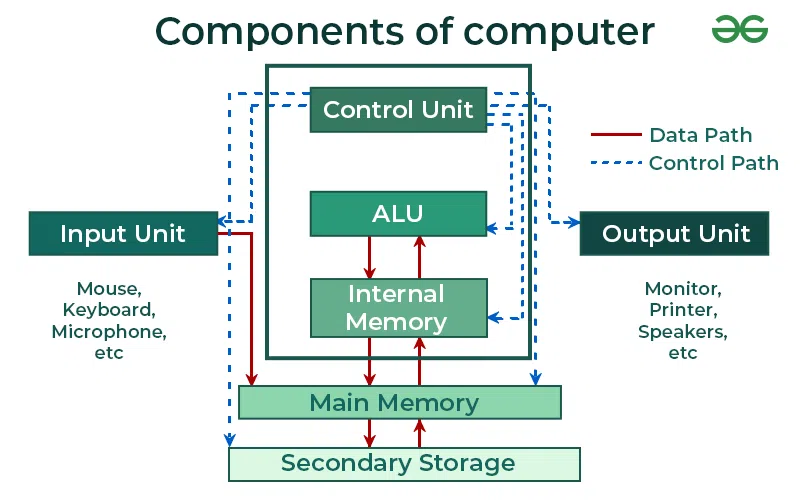
Components of a Computer
There are basically three important components of a computer:
- Central Processing Unit(CPU)
- Output Unit
1. Input Unit:
The input unit consists of input devices that are attached to the computer. These devices take input and convert it into binary language that the computer understands. Some of the common input devices are keyboard, mouse, joystick, scanner etc.
- The Input Unit is formed by attaching one or more input devices to a computer.
- A user input data and instructions through input devices such as a keyboard, mouse, etc.
- The input unit is used to provide data to the processor for further processing.
2. Central Processing Unit:
Once the information is entered into the computer by the input device, the processor processes it. The CPU is called the brain of the computer because it is the control centre of the computer. It first fetches instructions from memory and then interprets them so as to know what is to be done. If required, data is fetched from memory or input device. Thereafter CPU executes or performs the required computation, and then either stores the output or displays it on the output device. The CPU has three main components, which are responsible for different functions: Arithmetic Logic Unit (ALU), Control Unit (CU) and Memory registers
A. Arithmetic and Logic Unit (ALU): The ALU, as its name suggests performs mathematical calculations and takes logical decisions. Arithmetic calculations include addition, subtraction, multiplication and division. Logical decisions involve the comparison of two data items to see which one is larger or smaller or equal.
- Arithmetic Logical Unit is the main component of the CPU
- It is the fundamental building block of the CPU.
- Arithmetic and Logical Unit is a digital circuit that is used to perform arithmetic and logical operations.
B. Control Unit: The Control unit coordinates and controls the data flow in and out of the CPU, and also controls all the operations of ALU, memory registers and also input/output units. It is also responsible for carrying out all the instructions stored in the program. It decodes the fetched instruction, interprets it and sends control signals to input/output devices until the required operation is done properly by ALU and memory.
- The Control Unit is a component of the central processing unit of a computer that directs the operation of the processor.
- It instructs the computer’s memory, arithmetic and logic unit, and input and output devices on how to respond to the processor’s instructions.
- In order to execute the instructions, the components of a computer receive signals from the control unit.
- It is also called the central nervous system or brain of the computer.
C. Memory Registers: A register is a temporary unit of memory in the CPU. These are used to store the data, which is directly used by the processor. Registers can be of different sizes(16 bit, 32 bit, 64 bit and so on) and each register inside the CPU has a specific function, like storing data, storing an instruction, storing address of a location in memory etc. The user registers can be used by an assembly language programmer for storing operands, intermediate results etc. Accumulator (ACC) is the main register in the ALU and contains one of the operands of an operation to be performed in the ALU.
Memory attached to the CPU is used for the storage of data and instructions, and is called internal memory The internal memory is divided into many storage locations, each of which can store data or instructions. Each memory location is of the same size and has an address. With the help of the address, the computer can read any memory location easily without having to search the entire memory. When a program is executed, its data is copied to the internal memory and stored in the memory till the end of the execution. The internal memory is also called the Primary memory or Main memory. This memory is also called RAM, i.e., Random Access Memory. The time of access of data is independent of its location in memory, therefore, this memory is also called Random Access memory (RAM).
- Memory Unit is the primary storage of the computer.
- It stores both data and instructions.
- Data and instructions are stored permanently in this unit so that they are available whenever required.
3. Output Unit :
The output unit consists of output devices that are attached to the computer. It converts the binary data coming from the CPU to human understandable form. The common output devices are monitor, printer, plotter, etc.
- The output unit displays or prints the processed data in a user-friendly format.
- The output unit is formed by attaching the output devices of a computer.
- The output unit accepts the information from the CPU and displays it in a user-readable form.
Characteristics of a Computer
1. Speed: Computers can perform millions of calculations per second. The computation speed is extremely fast.
2. Accuracy: Because computers operate on pre-programmed software, there is no space for human error.
3. Diligence: They can perform complex and long calculations at the same time and with the same accuracy.
4. Versatile: Computers are designed to be versatile. They can carry out multiple operations at the same time.
5. Storage: Computers can store a large amount of data/ instructions in its memory, which can be retrieved at any point of time.
Please Login to comment...
Similar reads.
- Computer Subject

Improve your Coding Skills with Practice
What kind of Experience do you want to share?
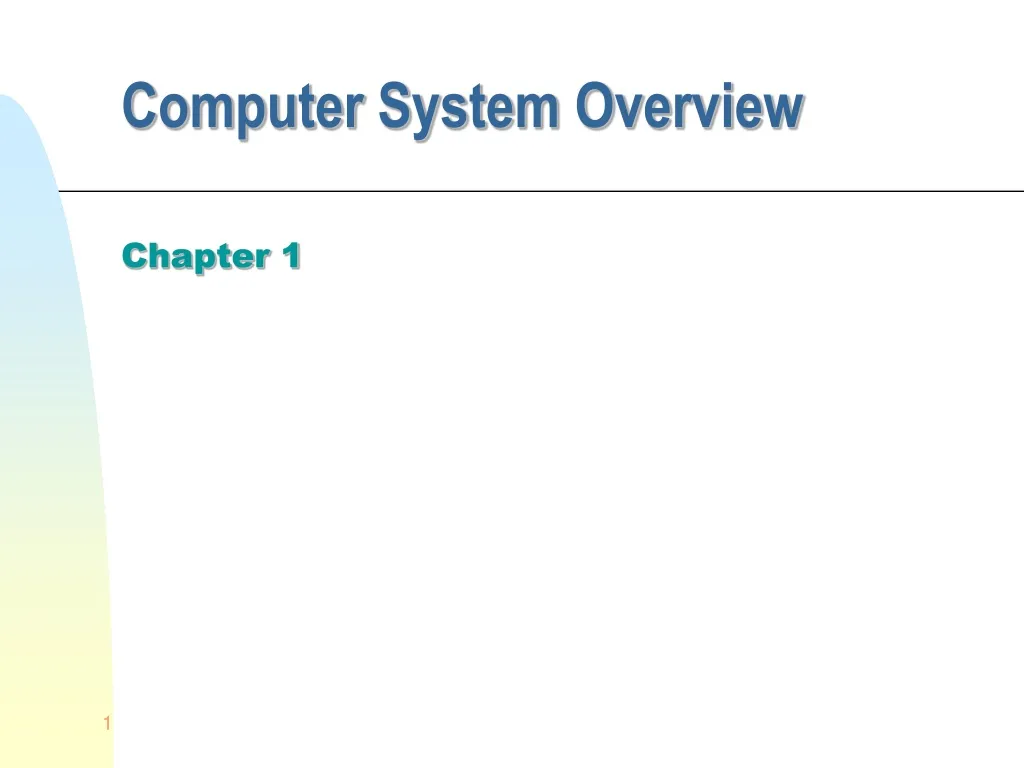
Computer System Overview
Jul 11, 2012
350 likes | 593 Views
Computer System Overview. Chapter 1. An Operating System makes the computing power available to users by controlling the hardware Let us review the aspects of computer hardware which are important for the OS. Basic Components. Processor (CPU) Main Memory (aka real memory, aka primary memory)
Share Presentation
- interrupt handler
- fast memory
- program counter
- control status registers
- program status word psw
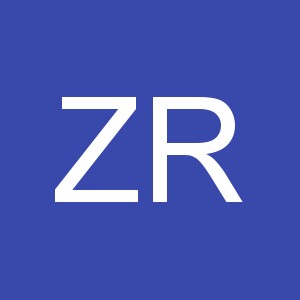
Presentation Transcript
Computer System Overview Chapter 1
An Operating System makes the computing power available to users by controlling the hardware • Let us review the aspects of computer hardware which are important for the OS
Basic Components • Processor (CPU) • Main Memory (aka real memory, aka primary memory) • holds data in code • I/O modules (I/O controllers, I/O channels, I/O processors...) • hardware (with registers called I/O ports) that moves data between cpu and peripherals like: • secondary memory devices (eg: hard disks) • keyboard, display... • communications equipment • System interconnection (ie: Buses) • communication among processors, memory, and I/O modules
I/O Module Structure • Data to/from system bus are buffered in data register(s) • Status/Control register(s) holds • current status information • current control information from • I/O logic interact with CPU via control bus • Contains logic specific to the interface of each device
CPU Registers (fast memory on cpu) • Control & Status Registers • Generally not available to user programs • some used by CPU to control its operation • some used by OS to control program execution • User-visible Registers • available to system (OS) and user programs • holds data, addresses, and some condition codes
Examples of Control & Status Registers • Program Counter (PC) • Contains the address of the next instruction to be fetched • Instruction Register (IR) • Contains the instruction most recently fetched • Program Status Word (PSW) • A register or group of registers containing: • condition codes and status info bits • Interrupt enable/disable bit • Supervisor(OS)/user mode bit
User-Visible Registers • Data Registers • can be assigned by the user program to perform operations on data • Address Registers • contain memory address of data and instructions • may contain a portion of an address that is used to calculate the complete address
User-Visible Registers • Examples of Address Registers • Index/Offset • involves adding an index to a base value to get an address • Segment pointer • when memory is divided into segments, memory is referenced by a segment and an offset • Stack pointer • points to top of stack
User-Visible Registers • Condition Codes or Flags • Bits set by the processor hardware as a result of operations • Can be accessed by a program but not changed directly • Examples • sign flag • zero flag • overflow flag
The Basic Instruction Cycle • The CPU fetches the next instruction (with operands) from memory. • Then the CPU executes the instruction • Program counter (PC) holds address of the instruction to be fetched next • Program counter is automatically incremented after each fetch
Then CPU must wait for I/O to complete! • WRITE transfer control to the printer driver (I/O pgm) • I/O pgm prepare I/O module for printing (4) • CPU has to WAIT for I/O command to complete • Long wait for a printer • I/O pgm finishes in (5) and report status of operation
Interrupts • Computers now permit I/O modules to INTERRUPT the CPU. • For this the I/O module just assert an interrupt request line on the control bus • Then CPU transfer control to an Interrupt Handler Routine (normally part of the OS)
Instruction Cycle with Interrupts! • CPU checks for interrupts after each instruction • If no interrupts, then fetch the next instruction for the current program • If an interrupt is pending, then suspend execution of the current program, and execute the interrupt handler
Interrupt Handler • Is a program that determines nature of the interrupt and performs whatever actions are needed • Control is transferred to this program • Control must be transferred back to the interrupted program so that it can be resumed from the point of interruption • This point of interruption can occur anywhere in the program • Thus: must save the state of the program (content of PC + PSW + registers + ...)
Simple Interrupt Processing
Interrupts improve CPU usage • I/O pgm prepares the I/O module and issues the I/O command (eg: to printer) • I/O pgm branches to user pgm • User code gets executed during I/O operation (eg: printing): no waiting • User pgm gets interrupted (x) when I/O operation is done and branches to interrupt handler to examine status of I/O module • Execution of user code resumes
Classes of Interrupts • I/O • signals normal completion of operation or error • Program Exception • overflows • try to execute illegal instruction • reference outside user’s memory space • Timer • preempts a pgm to perform another task • Hardware failure (eg: memory parity error)
Multiple interrupts: sequential order • Disable interrupts during an interrupt • Interrupts remain pending until the processor enables interrupts • After interrupt handler routine completes, the processor checks for additional interrupts
Multiple Interrupts: priorities • Higher priority interrupts cause lower-priority interrupts to wait • Causes a lower-priority interrupt handler to be interrupted • Example: when input arrives from communication line, it needs to be absorbed quickly to make room for more input
Multiprogramming • When a program reads a value on a I/O device it will need to wait for the I/O operation to complete • Interrupts are mostly effective when a single CPU is shared among several concurrently active processes. • The CPU can then switch to execute another program when a program waits for the result of the read operation. (more later)
I/O communication techniques • 3 techniques are possible for I/O operation • Programmed I/O • Does not use interrupts: CPU has to wait for completion of each I/O operation • Interrupt-driven I/O • CPU can execute code during I/O operation: it gets interrupted when I/O operation is done. • Direct Memory Access • A block of data is transferred directly from/to memory without going through CPU
Programmed I/O • I/O module performs the action, on behalf of the processor • But the I/O module does not interrupt the CPU when I/O is done • Processor is kept busy checking status of I/O module
Interrupt-Driven I/O • Processor is interrupted when I/O module ready to exchange data • Processor is free to do other work • No needless waiting • Consumes a lot of processor time because every word read or written passes through the processor
Direct Memory Access • CPU issues request to a DMA module (separate module or incorporated into I/O module) • DMA module transfers a block of data directly to or from memory (without going through CPU) • An interrupt is sent when the task is complete • The CPU is only involved at the beginning and end of the transfer • The CPU is free to perform other tasks during data transfer
Memory Hierarchy Cheaper Larger capacity Slower Registers Cache Main Memory Magnetic Disc Smaller frequency of access Removable Media
Cache Memory • Small cache of expensive but very fast memory interacting with slower but much larger memory • Invisible to OS and user programs but interact with other memory management hardware • Processor first checks if word referenced to is in cache • If not found in cache, a block of memory containing the word is moved to the cache
The Hit Ratio • Hit ratio = fraction of access where data is in cache • T1 = access time for fast memory • T2 = access time for slow memory • T2 >> T1 • When hit ratio is close to 1 the average access time is close to T1
Locality of reference • Memory reference for both instruction and data tend to cluster over a long period of time. • Example: once a loop is entered, there is frequent access to a small set of instructions. • Hence: once a word gets referenced, it is likely that nearby words will get referenced often in the near future. • Thus, the hit ratio will be close to 1 even for a small cache.
Disk Cache (same principles) • A portion of main memory used as a buffer to temporarily to hold data for the disk • Locality of reference also applies here: once a record gets referenced, it is likely that nearby records will get referenced often in the near future. • If a record referenced is not in the disk cache, the sector containing the record is moved into the disk cache.
- More by User
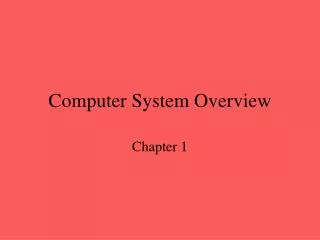
Computer System Overview. Chapter 1. Basic computer structure. Memory. CPU. memory bus. I/O bus. disk. Net interface. Computer System. Processor: performs data processing Main memory: stores both data and programs, typically volatile
541 views • 36 slides

Chapter 1 Computer System Overview
Chapter 1 Computer System Overview. Operating System. Exploits the hardware resources of one or more processors Provides a set of services to system users Manages secondary memory and I/O devices. Basic Elements. Processor Two internal registers Memory address resister (MAR)
676 views • 48 slides

Operating Systems: Internals and Design Principles. Chapter 1 Computer System Overview. Seventh Edition By William Stallings. Operating Systems: Internals and Design Principles.
787 views • 52 slides

Computer System Overview. Chapter 1. From: Operating Systems Internals and Design Principles by William Stallings. Operating System. Exploits the hardware resources of one or more processors Provides a set of services to system users Manages secondary memory and I/O devices. Basic Elements.
523 views • 51 slides
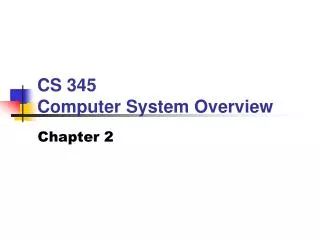
CS 345 Computer System Overview
CS 345 Computer System Overview. Chapter 2. Topics to Cover…. OS Objectives OS Services Resource Manager Evolution Achievements Processes Memory management Information protection and security Scheduling and resource management System architecture Virtual Machines. Objectives.
522 views • 30 slides

Computer System Overview. At a top level, a computer consists of processor, memory, and I/O components, with one or more modules of each type. These components are interconnected in some fashion to achieve the main function of the computer, which is to execute programs. Computer System….
632 views • 40 slides

Computer System Overview. Chapter 1. Operating System. Exploits the hardware resources of one or more processors Provides a set of services to system users Manages secondary memory and I/O devices. Basic Elements. Processor Main Memory referred to as real memory or primary memory
557 views • 42 slides

Computer System Overview. Chapter 1 Review of basic hardware concepts . The OS and the Hardware. An Operating System makes the computing power available to users by controlling the hardware Let us review the aspects of computer hardware which are important for the OS. Basic Components.
491 views • 35 slides

Operating Systems: Internals and Design Principles. Chapter 1 Computer System Overview. Seventh Edition By William Stallings. How Computer works. http:// www.homebrewcpu.com/photo_gallery.htm. Basic Elements. Processor. Main Memory. Volatile
728 views • 60 slides

Computer System Overview. Let’s figure out what’s inside this thing. Computer Systems. Registers Interrupts Caching Input/Output Protection Summary. Registers. CPU. Registers. Processor Registers. User-visible registers May be referenced by machine language
664 views • 43 slides

Operating System 1 COMPUTER SYSTEM OVERVIEW
Operating System 1 COMPUTER SYSTEM OVERVIEW. 1. BASIC ELEMENTS. There are four main structural elements: Processor: Controls the operation of the computer and performs its data processing functions. Main memory: Stores data and programs.
766 views • 37 slides
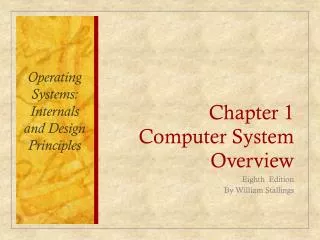
Operating Systems: Internals and Design Principles. Chapter 1 Computer System Overview. Eighth Edition By William Stallings. Operating System. Exploits the hardware resources of one or more processors Provides a set of services to system users Manages secondary memory and I/O devices.
723 views • 54 slides

Computer System Overview. Chapter 1. Operating System. Exploits the hardware resources of one or more processors Provides a set of services to system users Manages secondary memory and I/O devices. Basic Elements. Processor Main Memory volatile
602 views • 51 slides

Operating Systems: Internals and Design Principles. Chapter 1 Computer System Overview. Seventh Edition By William Stallings. How Computer works. Bill Buzbee (Google) Magic-1 http ://www.homebrewcpu.com /
933 views • 60 slides

Chapter 1 Computer System Overview. Sections 1.1 to 1.6 Instruction exe cution Interrupt Memory hierarchy Cache memory Locality : spatial and temporal Problem 1.10. Chapter 2 Operating System Overview. Sections 2.1 to 2.4 Objectives and functions of OS Evolution of OS
197 views • 10 slides
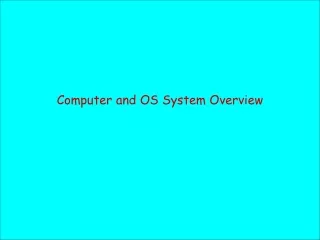
Computer and OS System Overview
Computer and OS System Overview. Introduction. A computer system consists of hardware system programs application programs. Operating System. Provides a set of services to system users (collection of service programs) Shield between the user and the hardware Resource manager : CPU(s)
755 views • 75 slides

331 views • 29 slides

379 views • 37 slides

Computer System Overview. Introduction. A computer system consists of hardware system programs application programs. Operating System. Provides a set of services to system users (collection of service programs) Shield between the user and the hardware Resource manager : CPU(s)
616 views • 59 slides

Computer System Overview. B.Ramamurthy Chapter 1. Basic Elements. Processor: control unit and registers Register : User visible, control and status registers User visible: R0.. R32, data registers, address registers, stack pointer..
273 views • 12 slides
Got any suggestions?
We want to hear from you! Send us a message and help improve Slidesgo
Top searches
Trending searches

46 templates

suicide prevention
8 templates

49 templates

18 templates

41 templates
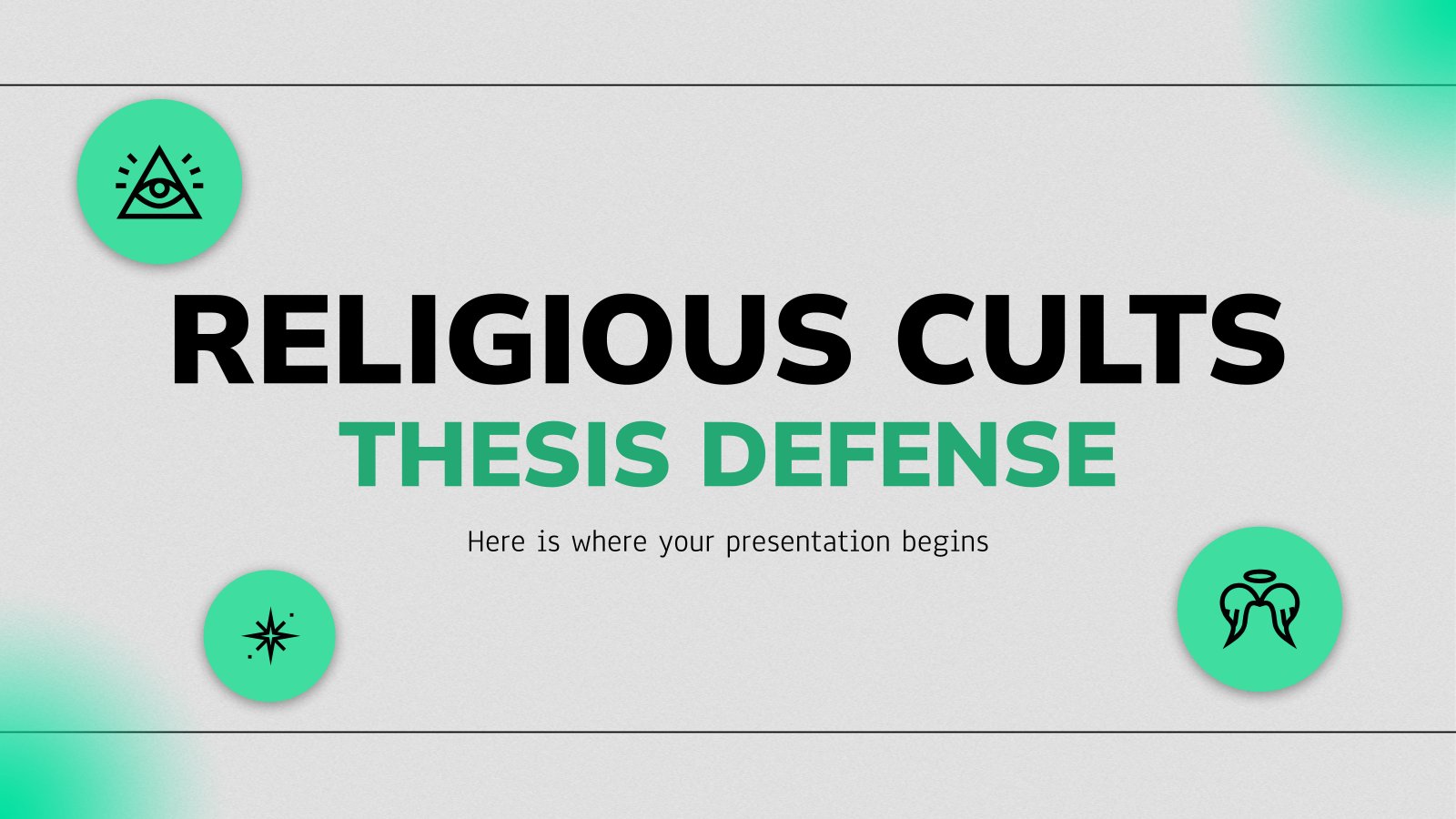
29 templates
Computer Presentation templates
Use these google slides themes or download our ppt files for powerpoint or keynote to give a presentation about a computer-related topic, including information technology..
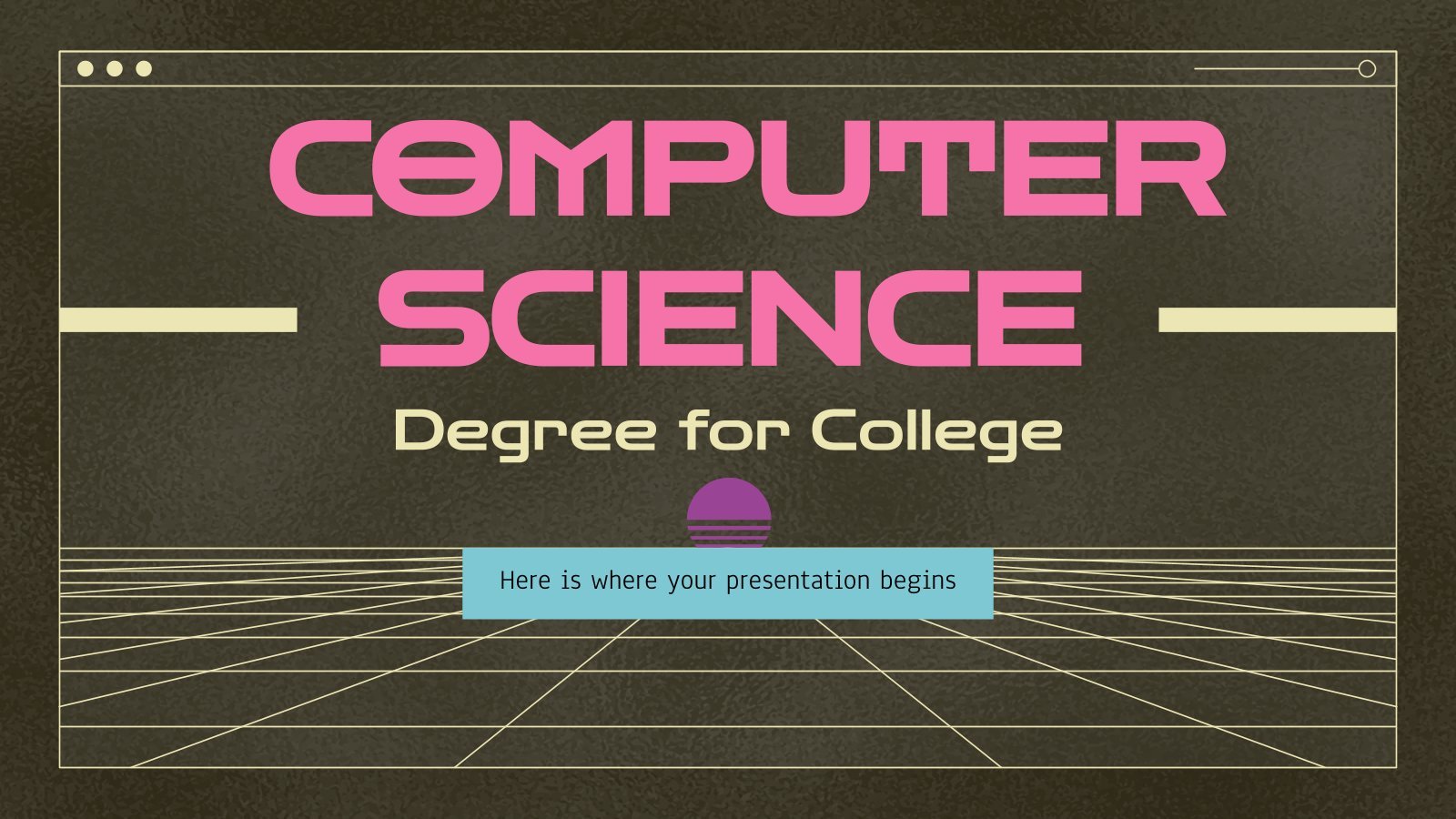
Computer Science Degree for College
Computer science degrees prepare students for the jobs of the future (and the present!). If you are interested in getting an education about coding, math, computers, and robots, this is the degree for you! Speak about it with this futuristic template that will take the viewers to another digital dimension....
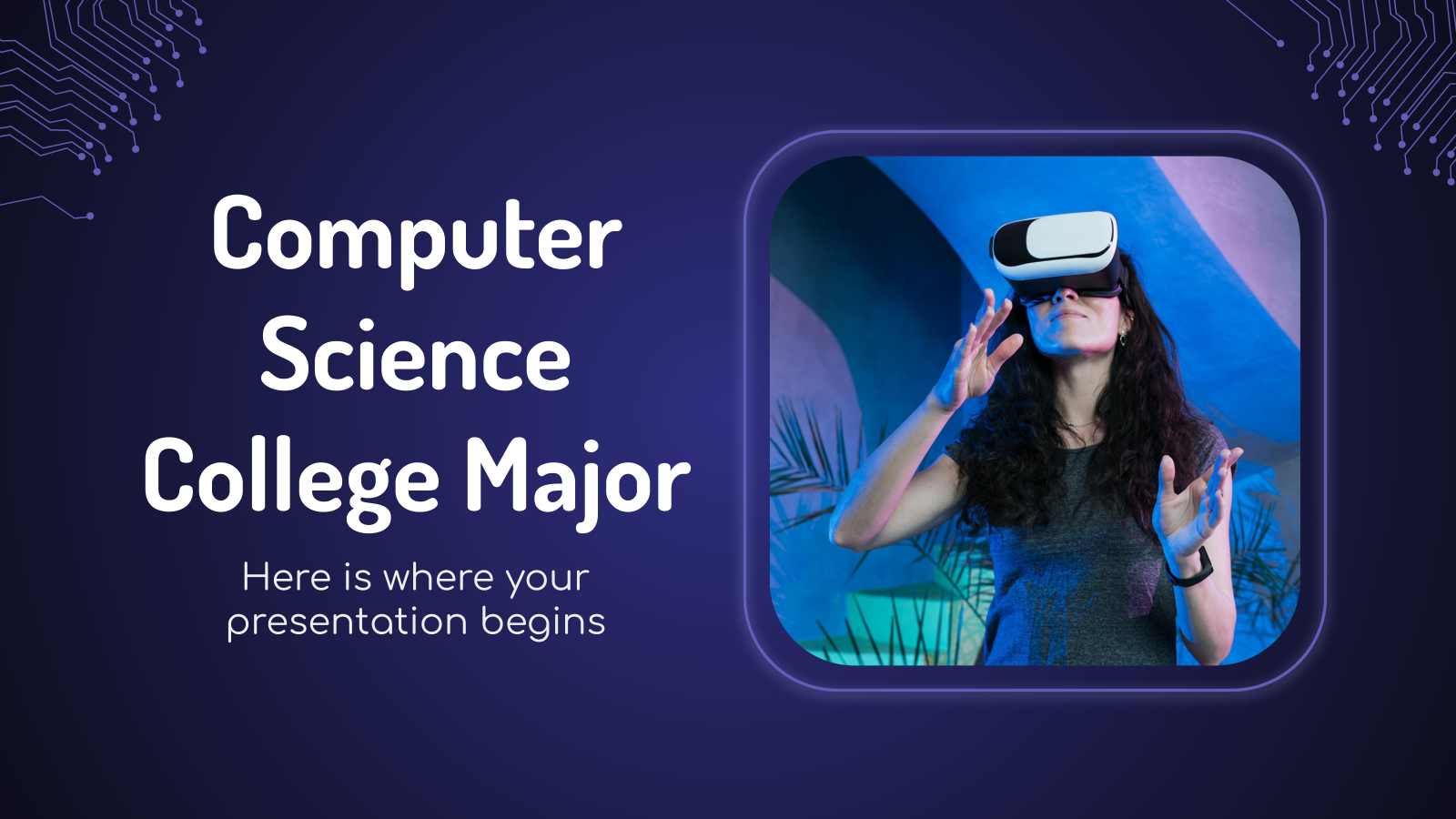
Premium template
Unlock this template and gain unlimited access
Computer Science College Major
If you are a guru of computers, most likely you've studied computer science in college. Would you like to show others what a major in this field has to offer and what it could contribute to their professional development? Customize this template and let them feel the future, at least...

Linear Grid Newsletter
Give an original touch to your employee newsletters with this grid design. It perfectly combines colors like green, yellow or orange with geometric icons to give dynamism to your news. You can use a different tone for each section, so they can be easily differentiated. Report on the latest company...
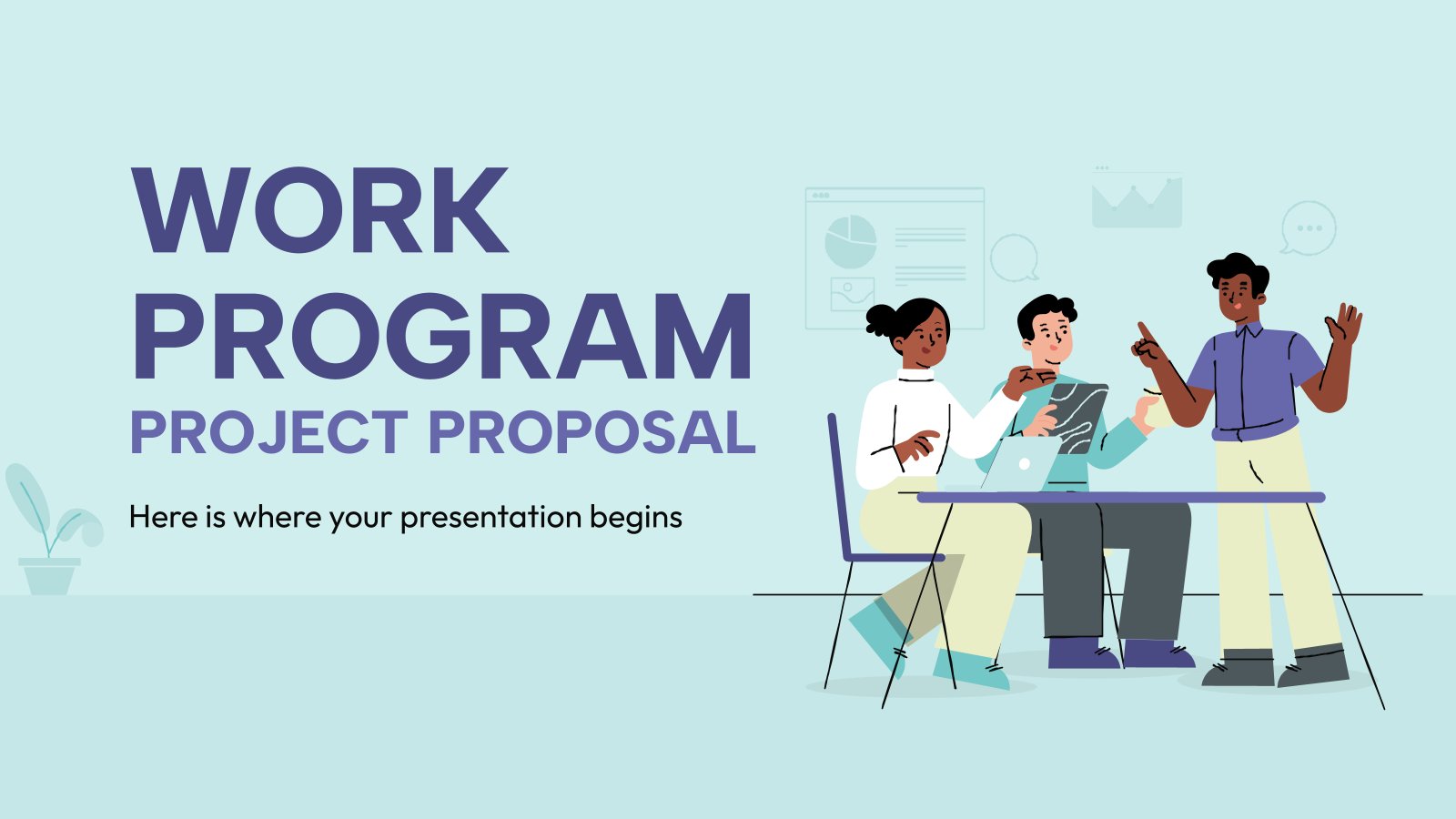
Work Program Project Proposal
Download the "Work Program Project Proposal" presentation for PowerPoint or Google Slides. A well-crafted proposal can be the key factor in determining the success of your project. It's an opportunity to showcase your ideas, objectives, and plans in a clear and concise manner, and to convince others to invest their...

Virtual Slides for Education Day
Digital learning is making its way into the world of education. For this reason, we've designed this new template so that the slides look like the screen of a laptop (complete with reflections!). Apart from graphs and infographics, the font is quite "computer-esque" and a perfect fit for this theme....
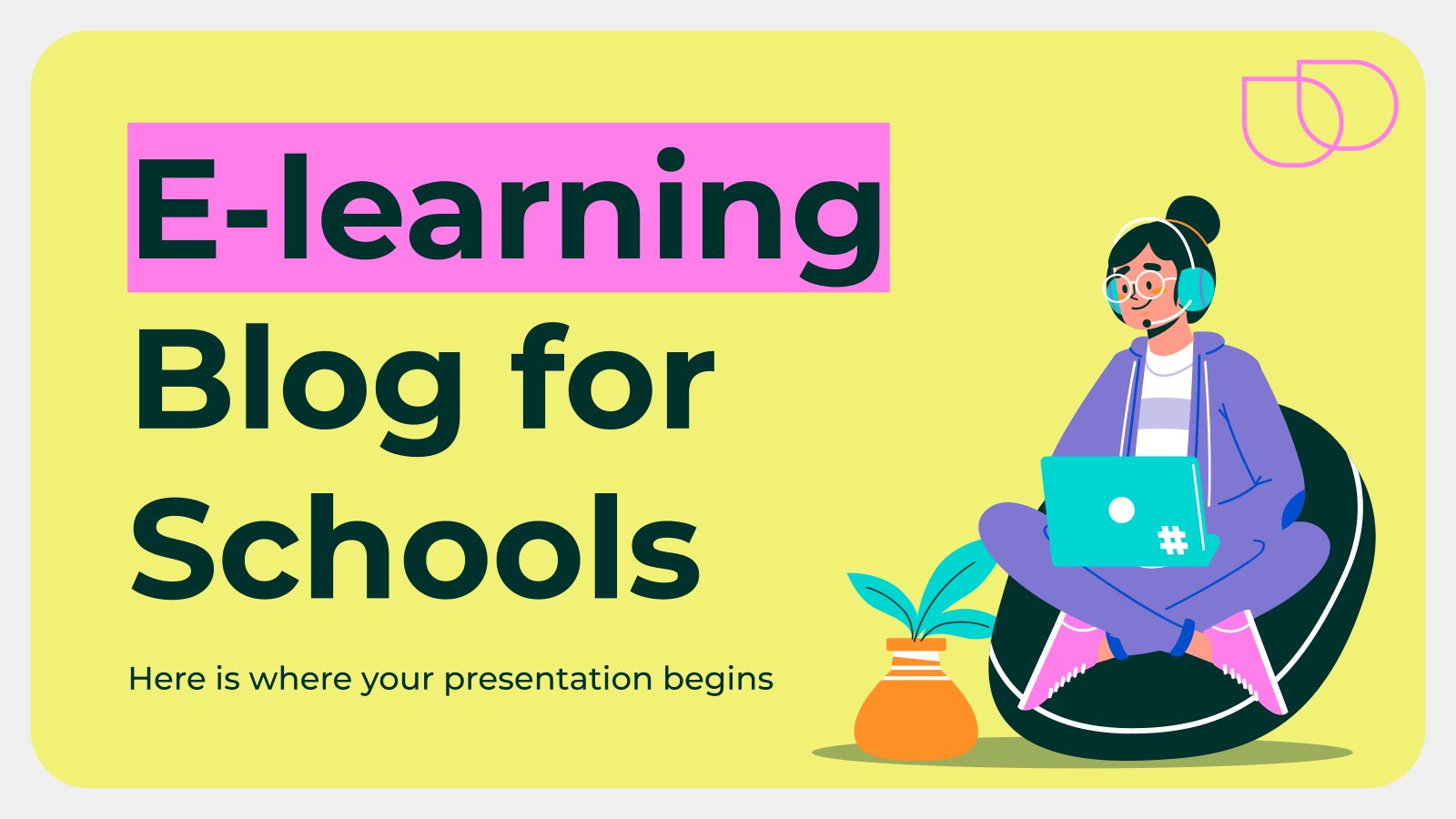
E-learning Blog for Schools
Download the "E-learning Blog for Schools" presentation for PowerPoint or Google Slides. Attention all marketers! Are you looking for a way to make your newsletters more creative and eye-catching for your target audience? This amazing template is perfect for creating the perfect newsletter that will capture your audience's attention from...
Silicon Valley Programmer Minitheme
No matter your actual profession, you can’t say you’ve never ever imagined being one of those fabled Silicon Valley programmers that make alternate realities come to life and can make us question the structures that govern our world. The good news: With this minitheme, you can join them for a...
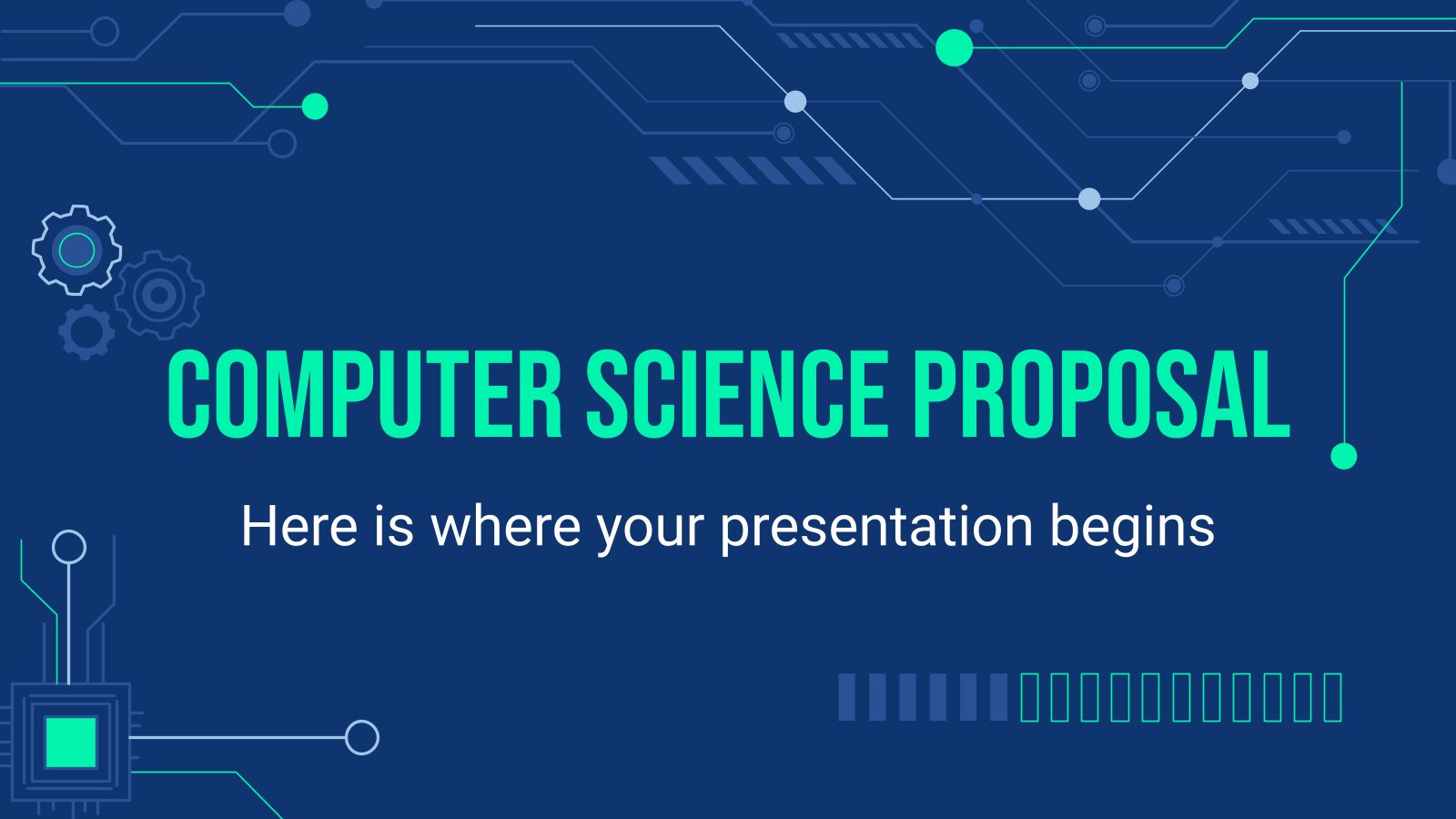
Computer Science Proposal
A slide deck whose overall look and feel is very techie is what you need to put forward a proposal for a computer science project. And that’s what you’ll get with this template. The details on the backgrounds are so enticing and the neon tone used for the text contrasts...
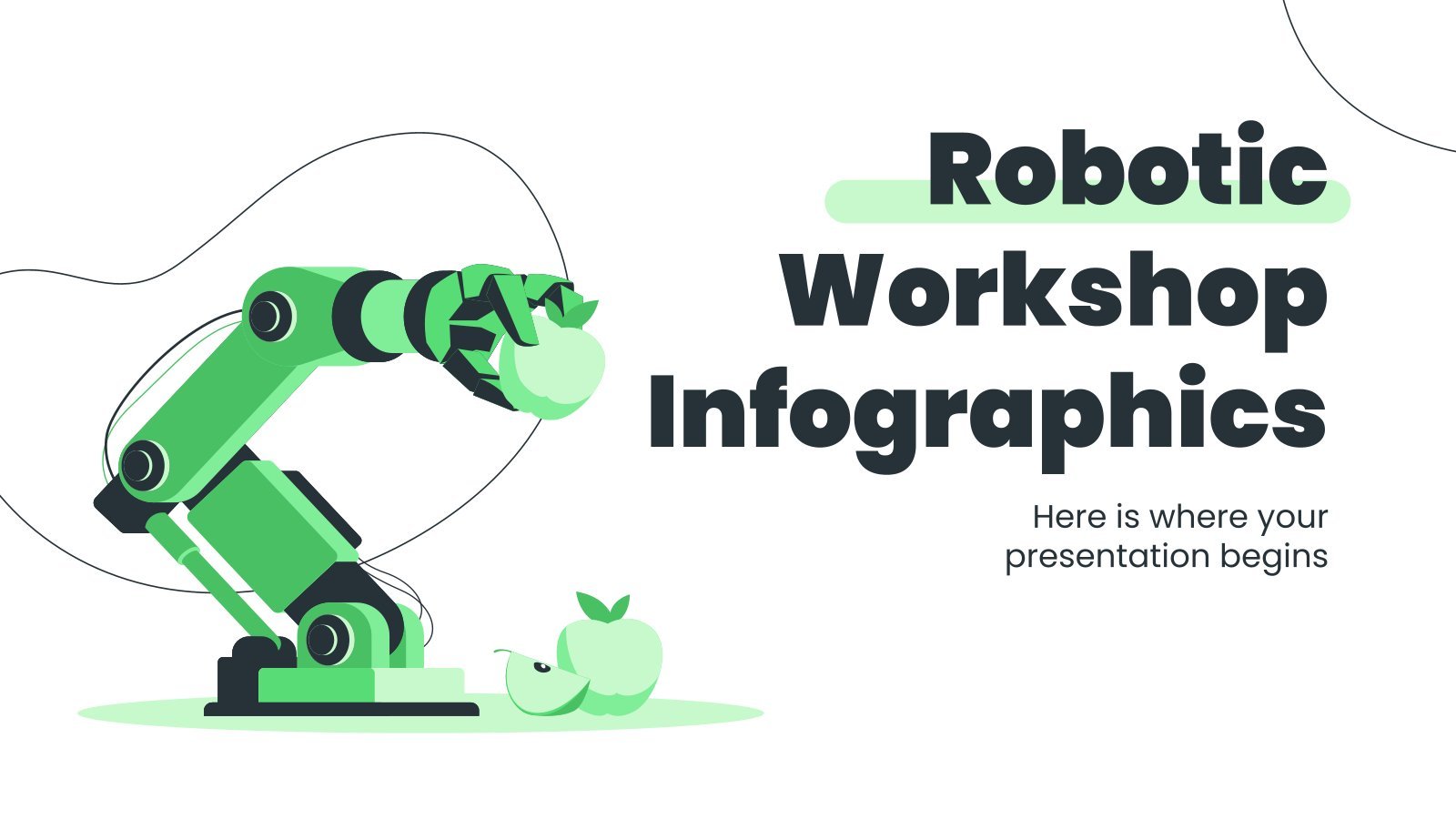
Robotic Workshop Infographics
Download the "Robotic Workshop Infographics" template for PowerPoint or Google Slides and discover the power of infographics. An infographic resource gives you the ability to showcase your content in a more visual way, which will make it easier for your audience to understand your topic. Slidesgo infographics like this set...

Soft Colors UI Design for Agencies
Agencies have the most creative employees, so having boring meetings with traditional Google Slides & PowerPoint presentations would be a waste. Make the most out of this potential with this creative design full of editable resources and beautiful decorations in calming, pastel tones. Let the creativity of your agency be...
Silicon Valley Programmer Portfolio
Download the "Silicon Valley Programmer Portfolio" presentation for PowerPoint or Google Slides. When a potential client or employer flips through the pages of your portfolio, they're not just looking at your work; they're trying to get a sense of who you are as a person. That's why it's crucial to...
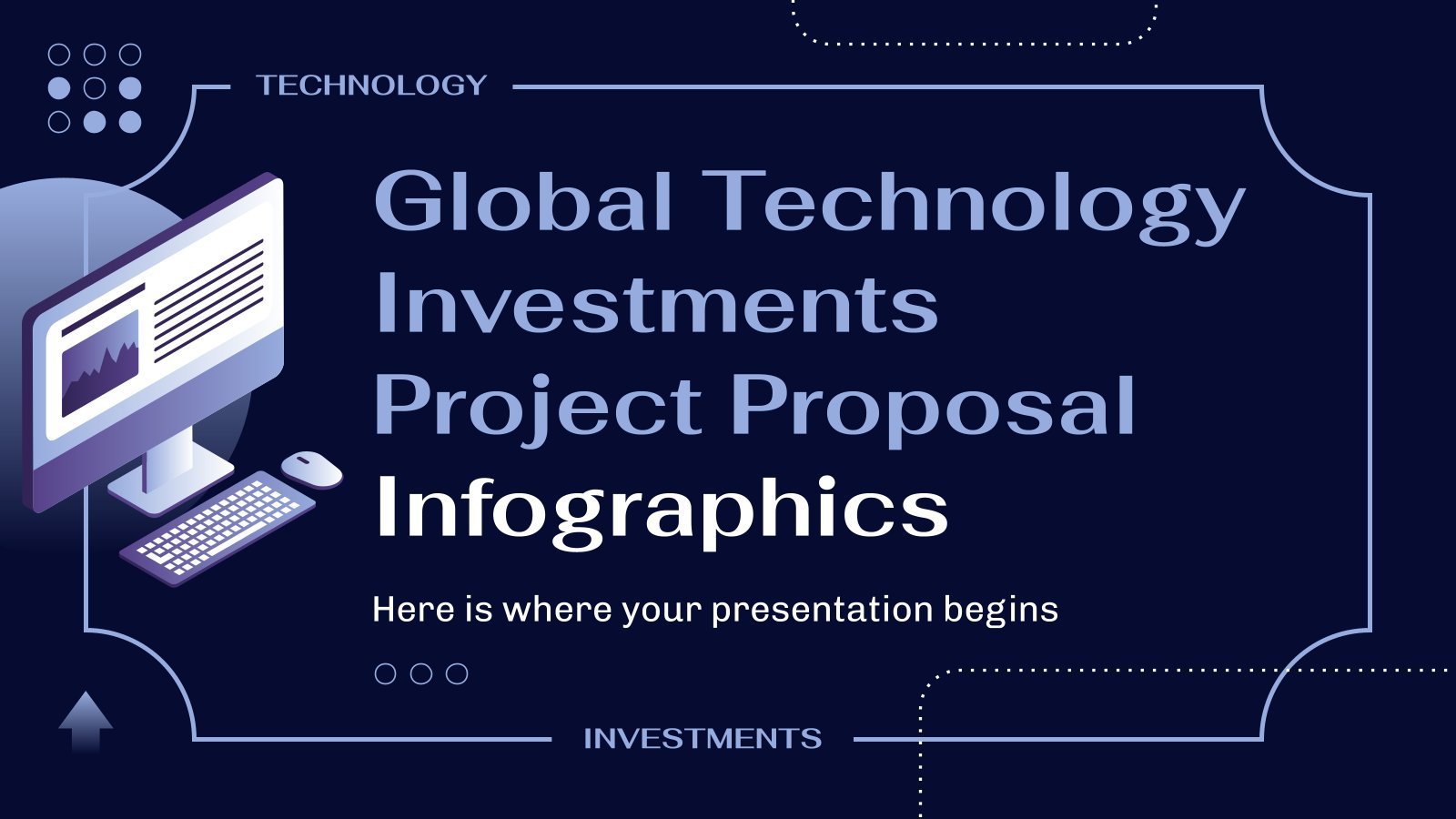
Global Technology Investments Project Proposal Infographics
Download the "Global Technology Investments Project Proposal Infographics" template for PowerPoint or Google Slides to get the most out of infographics. Whether you want to organize your business budget in a table or schematically analyze your sales over the past year, this set of infographic resources will be of great...
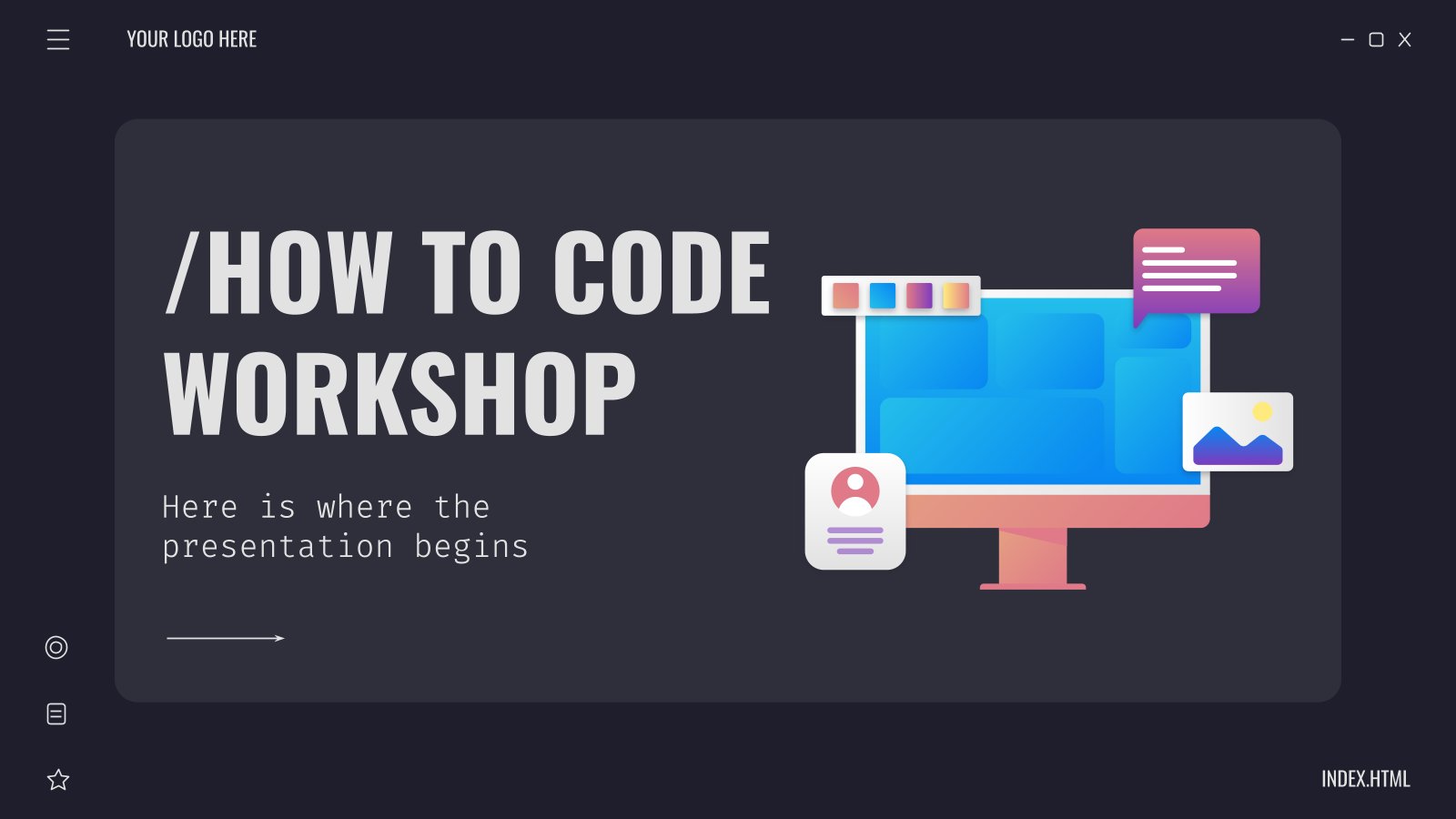
How to Code Workshop
Are you an expert of Java? Yes, it's a beautiful island in Indonesia and more than half of the population of this country lives there... No! Well, yes, those facts are true, but we were talking about the programming language! We think workshops on how to code are a necessity,...

Multimedia Software Pitch Deck
Download the "Multimedia Software Pitch Deck" presentation for PowerPoint or Google Slides. Whether you're an entrepreneur looking for funding or a sales professional trying to close a deal, a great pitch deck can be the difference-maker that sets you apart from the competition. Let your talent shine out thanks to...

Web Project Proposal
We live in the internet era, which means that web design is currently one of the most demanded skills. This free template is perfect for those designers who want to present their web project proposal to their clients and see a preview of the final work.

Tech Startup Newsletter
Download the "Tech Startup Newsletter" presentation for PowerPoint or Google Slides. Attention all marketers! Are you looking for a way to make your newsletters more creative and eye-catching for your target audience? This amazing template is perfect for creating the perfect newsletter that will capture your audience's attention from the...
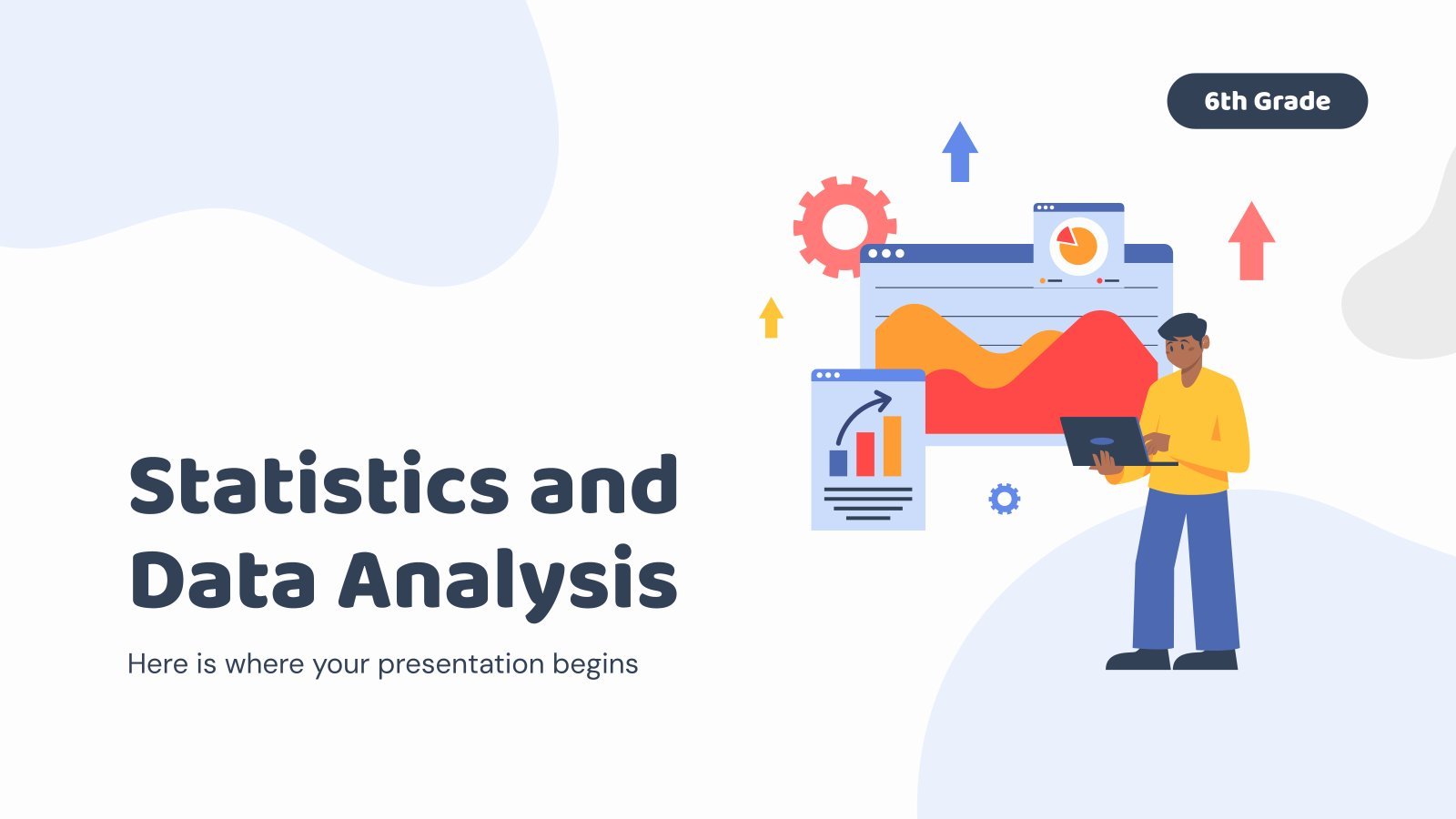
Statistics and Data Analysis - 6th Grade
Download the "Statistics and Data Analysis - 6th Grade" presentation for PowerPoint or Google Slides. If you’re looking for a way to motivate and engage students who are undergoing significant physical, social, and emotional development, then you can’t go wrong with an educational template designed for Middle School by Slidesgo!...
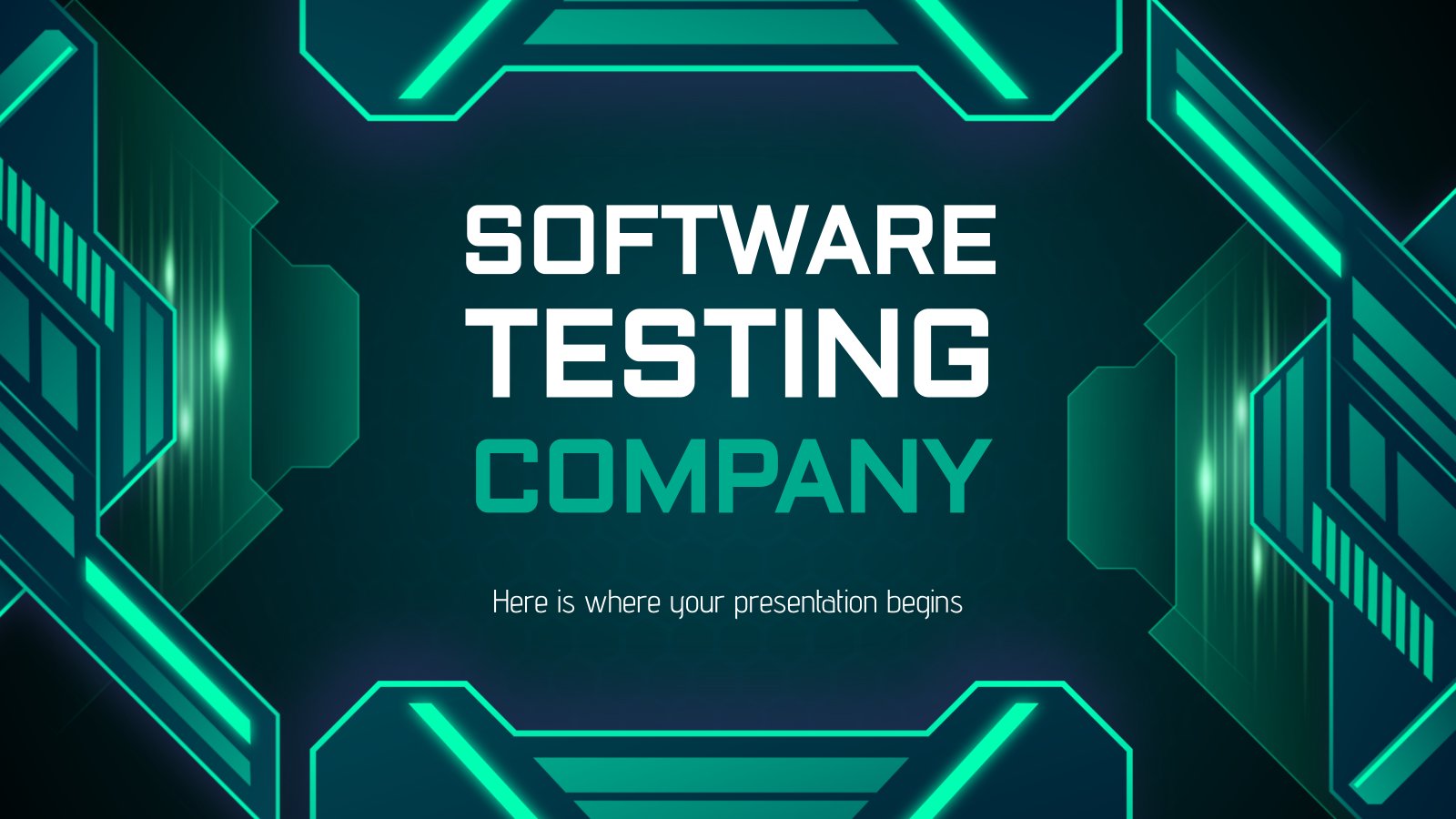
Software Testing Company
Software testing might not be the sexiest part of coding, but that doesn't mean it lacks intrigue or importance. After all, who wants to use a buggy app? It's software testing that ensures smooth operation and prevents annoying glitches from making it into the final product. Without it, our lives...
- Page 1 of 29
New! Make quick presentations with AI
Slidesgo AI presentation maker puts the power of design and creativity in your hands, so you can effortlessly craft stunning slideshows in minutes.

Register for free and start editing online
- MyU : For Students, Faculty, and Staff
Fall 2024 CSCI Special Topics Courses
Cloud computing.
Meeting Time: 09:45 AM‑11:00 AM TTh Instructor: Ali Anwar Course Description: Cloud computing serves many large-scale applications ranging from search engines like Google to social networking websites like Facebook to online stores like Amazon. More recently, cloud computing has emerged as an essential technology to enable emerging fields such as Artificial Intelligence (AI), the Internet of Things (IoT), and Machine Learning. The exponential growth of data availability and demands for security and speed has made the cloud computing paradigm necessary for reliable, financially economical, and scalable computation. The dynamicity and flexibility of Cloud computing have opened up many new forms of deploying applications on infrastructure that cloud service providers offer, such as renting of computation resources and serverless computing. This course will cover the fundamentals of cloud services management and cloud software development, including but not limited to design patterns, application programming interfaces, and underlying middleware technologies. More specifically, we will cover the topics of cloud computing service models, data centers resource management, task scheduling, resource virtualization, SLAs, cloud security, software defined networks and storage, cloud storage, and programming models. We will also discuss data center design and management strategies, which enable the economic and technological benefits of cloud computing. Lastly, we will study cloud storage concepts like data distribution, durability, consistency, and redundancy. Registration Prerequisites: CS upper div, CompE upper div., EE upper div., EE grad, ITI upper div., Univ. honors student, or dept. permission; no cr for grads in CSci. Complete the following Google form to request a permission number from the instructor ( https://forms.gle/6BvbUwEkBK41tPJ17 ).
CSCI 5980/8980
Machine learning for healthcare: concepts and applications.
Meeting Time: 11:15 AM‑12:30 PM TTh Instructor: Yogatheesan Varatharajah Course Description: Machine Learning is transforming healthcare. This course will introduce students to a range of healthcare problems that can be tackled using machine learning, different health data modalities, relevant machine learning paradigms, and the unique challenges presented by healthcare applications. Applications we will cover include risk stratification, disease progression modeling, precision medicine, diagnosis, prognosis, subtype discovery, and improving clinical workflows. We will also cover research topics such as explainability, causality, trust, robustness, and fairness.
Registration Prerequisites: CSCI 5521 or equivalent. Complete the following Google form to request a permission number from the instructor ( https://forms.gle/z8X9pVZfCWMpQQ6o6 ).
Visualization with AI
Meeting Time: 04:00 PM‑05:15 PM TTh Instructor: Qianwen Wang Course Description: This course aims to investigate how visualization techniques and AI technologies work together to enhance understanding, insights, or outcomes.
This is a seminar style course consisting of lectures, paper presentation, and interactive discussion of the selected papers. Students will also work on a group project where they propose a research idea, survey related studies, and present initial results.
This course will cover the application of visualization to better understand AI models and data, and the use of AI to improve visualization processes. Readings for the course cover papers from the top venues of AI, Visualization, and HCI, topics including AI explainability, reliability, and Human-AI collaboration. This course is designed for PhD students, Masters students, and advanced undergraduates who want to dig into research.
Registration Prerequisites: Complete the following Google form to request a permission number from the instructor ( https://forms.gle/YTF5EZFUbQRJhHBYA ). Although the class is primarily intended for PhD students, motivated juniors/seniors and MS students who are interested in this topic are welcome to apply, ensuring they detail their qualifications for the course.
Visualizations for Intelligent AR Systems
Meeting Time: 04:00 PM‑05:15 PM MW Instructor: Zhu-Tian Chen Course Description: This course aims to explore the role of Data Visualization as a pivotal interface for enhancing human-data and human-AI interactions within Augmented Reality (AR) systems, thereby transforming a broad spectrum of activities in both professional and daily contexts. Structured as a seminar, the course consists of two main components: the theoretical and conceptual foundations delivered through lectures, paper readings, and discussions; and the hands-on experience gained through small assignments and group projects. This class is designed to be highly interactive, and AR devices will be provided to facilitate hands-on learning. Participants will have the opportunity to experience AR systems, develop cutting-edge AR interfaces, explore AI integration, and apply human-centric design principles. The course is designed to advance students' technical skills in AR and AI, as well as their understanding of how these technologies can be leveraged to enrich human experiences across various domains. Students will be encouraged to create innovative projects with the potential for submission to research conferences.
Registration Prerequisites: Complete the following Google form to request a permission number from the instructor ( https://forms.gle/Y81FGaJivoqMQYtq5 ). Students are expected to have a solid foundation in either data visualization, computer graphics, computer vision, or HCI. Having expertise in all would be perfect! However, a robust interest and eagerness to delve into these subjects can be equally valuable, even though it means you need to learn some basic concepts independently.
Sustainable Computing: A Systems View
Meeting Time: 09:45 AM‑11:00 AM Instructor: Abhishek Chandra Course Description: In recent years, there has been a dramatic increase in the pervasiveness, scale, and distribution of computing infrastructure: ranging from cloud, HPC systems, and data centers to edge computing and pervasive computing in the form of micro-data centers, mobile phones, sensors, and IoT devices embedded in the environment around us. The growing amount of computing, storage, and networking demand leads to increased energy usage, carbon emissions, and natural resource consumption. To reduce their environmental impact, there is a growing need to make computing systems sustainable. In this course, we will examine sustainable computing from a systems perspective. We will examine a number of questions: • How can we design and build sustainable computing systems? • How can we manage resources efficiently? • What system software and algorithms can reduce computational needs? Topics of interest would include: • Sustainable system design and architectures • Sustainability-aware systems software and management • Sustainability in large-scale distributed computing (clouds, data centers, HPC) • Sustainability in dispersed computing (edge, mobile computing, sensors/IoT)
Registration Prerequisites: This course is targeted towards students with a strong interest in computer systems (Operating Systems, Distributed Systems, Networking, Databases, etc.). Background in Operating Systems (Equivalent of CSCI 5103) and basic understanding of Computer Networking (Equivalent of CSCI 4211) is required.
- Future undergraduate students
- Future transfer students
- Future graduate students
- Future international students
- Diversity and Inclusion Opportunities
- Learn abroad
- Living Learning Communities
- Mentor programs
- Programs for women
- Student groups
- Visit, Apply & Next Steps
- Information for current students
- Departments and majors overview
- Departments
- Undergraduate majors
- Graduate programs
- Integrated Degree Programs
- Additional degree-granting programs
- Online learning
- Academic Advising overview
- Academic Advising FAQ
- Academic Advising Blog
- Appointments and drop-ins
- Academic support
- Commencement
- Four-year plans
- Honors advising
- Policies, procedures, and forms
- Career Services overview
- Resumes and cover letters
- Jobs and internships
- Interviews and job offers
- CSE Career Fair
- Major and career exploration
- Graduate school
- Collegiate Life overview
- Scholarships
- Diversity & Inclusivity Alliance
- Anderson Student Innovation Labs
- Information for alumni
- Get engaged with CSE
- Upcoming events
- CSE Alumni Society Board
- Alumni volunteer interest form
- Golden Medallion Society Reunion
- 50-Year Reunion
- Alumni honors and awards
- Outstanding Achievement
- Alumni Service
- Distinguished Leadership
- Honorary Doctorate Degrees
- Nobel Laureates
- Alumni resources
- Alumni career resources
- Alumni news outlets
- CSE branded clothing
- International alumni resources
- Inventing Tomorrow magazine
- Update your info
- CSE giving overview
- Why give to CSE?
- College priorities
- Give online now
- External relations
- Giving priorities
- Donor stories
- Impact of giving
- Ways to give to CSE
- Matching gifts
- CSE directories
- Invest in your company and the future
- Recruit our students
- Connect with researchers
- K-12 initiatives
- Diversity initiatives
- Research news
- Give to CSE
- CSE priorities
- Corporate relations
- Information for faculty and staff
- Administrative offices overview
- Office of the Dean
- Academic affairs
- Finance and Operations
- Communications
- Human resources
- Undergraduate programs and student services
- CSE Committees
- CSE policies overview
- Academic policies
- Faculty hiring and tenure policies
- Finance policies and information
- Graduate education policies
- Human resources policies
- Research policies
- Research overview
- Research centers and facilities
- Research proposal submission process
- Research safety
- Award-winning CSE faculty
- National academies
- University awards
- Honorary professorships
- Collegiate awards
- Other CSE honors and awards
- Staff awards
- Performance Management Process
- Work. With Flexibility in CSE
- K-12 outreach overview
- Summer camps
- Outreach events
- Enrichment programs
- Field trips and tours
- CSE K-12 Virtual Classroom Resources
- Educator development
- Sponsor an event

IMAGES
VIDEO
COMMENTS
PRESENTATION ON COMPUTER SYSTEM. Jul 6, 2015 •. 49 likes • 133,526 views. D. Deepanshu Saini. 1 of 13. Download now. Download to read offline. PRESENTATION ON COMPUTER SYSTEM - Download as a PDF or view online for free.
The computer program ( software ) is an essential component of every computer system which directs the computer to performs various tasks. The Computer system is programmable. That means, the computer will perform the task only as per the program instructions. The accuracy of the output depends upon the accuracy of the program instructions.
Step 1.When you start the computer, certain operating system files are loaded into RAM from the hard disk. The operating system displays the user interface on the screen. Operating system interface Operating system instructions Step 2.When you start a Web browser, the program's instructions are loaded into RAM from the hard disk.
PDF of this presentation 1 ... "Principles of Computer System Design: An Introduction ", by Jerome H. Saltzer and M. Frans Kaashoek Lecture 01: Welcome to CS110: P rinciples of Computer Systems 11. Lecture Examples Lectures will be driv en by slides and coding examples, and all coding examples can be copied/cloned into local
Introduction To Computer System.Beginners Complete Introduction To Computer System.Definition, Components, Features And Characteristics Of Computer कंप्यूटर ...
Carnegie Mellon Bryant and O'Hallaron, Computer Systems: A Programmer's Perspective, Third Edition 5 Intel x86 Processors Dominate laptop/desktop/server market Evolutionary design Backwards compatible up until 8086, introduced in 1978 Added more features as time goes on x86 is a Complex Instruction Set Computer (CISC) Many different instructions with many different formats
Download ppt "Chapter 1: Introduction to Computer". Computer A computer is an electronic device, operating under the control of instructions stored in its own memory that can accept data (input), process the data according to specified rules, produce information (output), and store the information for future use.
35. Mother board A motherboard is the main circuit board inside a computer that connects the different parts of a computer together. It has sockets for the CPU, RAM and expansion cards (e.g. discrete graphics cards, sound cards, network cards, storage cards etc)… and it also hooks up to hard drives, disc drives and front panel ports with cables and wires.
Computer systems is easy to learn. Devices & Hardware. 1 of 19. Download Now. Download to read offline. Computer systems - Download as a PDF or view online for free.
557 likes • 537,806 views. S. Suaj. basics of computer system ppt. Education Technology. 1 of 33. Download now. Download to read offline. basics of computer system ppt - Download as a PDF or view online for free.
A computer is an electronic device that manipulates information, or data. It has the ability to store, retrieve, and process data. You may already know that you can use a computer to type documents, send email, play games, and browse the Web. You can also use it to edit or create spreadsheets, presentations, and even videos.
Presentation Transcript. Introduction to computer fundamentals. The Computer Defined • A computer is an electronic device that processes data, converting it into information that is useful to people. Analog and Digital Computer • Analog systems represent data as variable points along a continuous spectrum of values.
computer, device for processing, storing, and displaying information.. Computer once meant a person who did computations, but now the term almost universally refers to automated electronic machinery.The first section of this article focuses on modern digital electronic computers and their design, constituent parts, and applications. The second section covers the history of computing.
Computer System Components Presentation Instructions. Computer System Components Presentation Instructions Use the Navigation Buttons at the bottom of this window to move through the presentation. Use the "Home" Button to go to the Menu if you want to jump to a specific section. END Main Menu Basic Computer Tasks Block Diagram
A computer is an electronic device that can be programmed to accept data (input), process it and generate result (output). A computer along with additional hardware and software together is called a computer system. A computer system primarily comprises a central processing unit (CPU), memory, input/output devices and storage devices.
Components of a Computer System. A computer system is made up of several key components, including the central processing unit (CPU), memory, storage, input devices, output devices, and connectivity hardware. The CPU is the brain of the computer, while memory stores data temporarily for processing. Storage devices provide long-term data storage.
A computer as shown below performs basically five major operations or functions irrespective of their size and make. These are 1) it accepts data or instructions by way of input, 2) it stores data, 3) it can process data as required by the user, 4) it gives results in the form of output, and 5) it controls all operations inside a computer.
A computer is an electronic device that accepts data, performs operations, displays results, and stores the data or results as needed. It is a combination of hardware and software resources that integrate together and provides various functionalities to the user. Hardware is the physical components of a computer like a processor, memory devices, monitor, keyboard, etc., while software is a set ...
Storage: The computer's ability to store and retrieve data. Data is stored in various types of storage devices, such as hard disk drives (HDDs), solid-state drives (SSDs), optical disks, and flash drives. Input: The process of providing data and instructions to the computer system. This can be done through input devices like keyboards, mice ...
Presentation Transcript. Computer System Overview Chapter 1. An Operating System makes the computing power available to users by controlling the hardware • Let us review the aspects of computer hardware which are important for the OS. Basic Components • Processor (CPU) • Main Memory (aka real memory, aka primary memory) • holds data in ...
Download our Computer-related Google Slides themes and PowerPoint templates and create outstanding presentations Free Easy to edit Professional ... Use these Google Slides themes or download our PPT files for PowerPoint or Keynote to give a presentation about a Computer-related topic, including Information Technology. Filter by. Filters ...
Presentation on operating system - Download as a PDF or view online for free ... Make a computer system easier to use:- An operating system hides details of hardware resources from programmers and other users and provides them with a convenient interface for using a computer system. (2). Manage the resources of a computer system:- An operating ...
For an IT-themed slideshow presentation, you can insert elements like computer screens, circuit boards, binary code, server racks, and images of technology devices. Additionally, you can use icons representing programming languages, network diagrams, and cybersecurity symbols to enhance the relevance and visual appeal of your presentation.
Visualization with AI. Meeting Time: 04:00 PM‑05:15 PM TTh. Instructor: Qianwen Wang. Course Description: This course aims to investigate how visualization techniques and AI technologies work together to enhance understanding, insights, or outcomes. This is a seminar style course consisting of lectures, paper presentation, and interactive ...
It is with great pleasure that we announce the guest lecture of Ian Smith, Director of the Georg Nemetschek Institute, AI for the Built World, at the Technical University of Munich, Germany. It will take place on Tuesday May 7th, 10:30-11:30AM, in Y2E2 299. Ian will discuss the challenges of computing for engineers in the built world and the opportunities for using AI. He will particularly ...